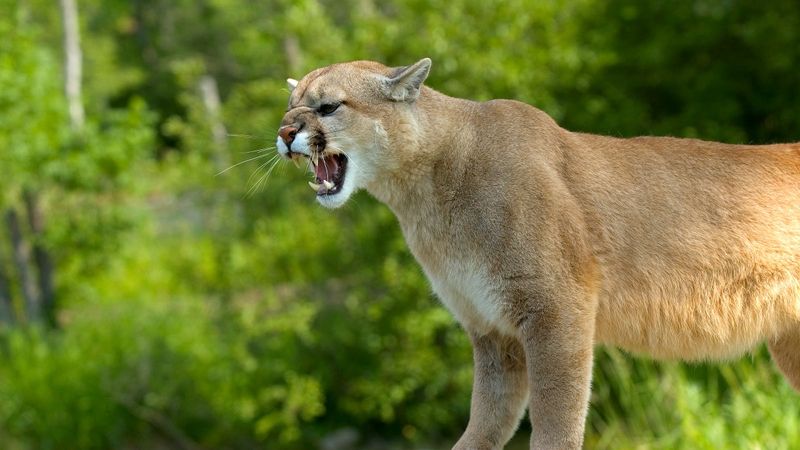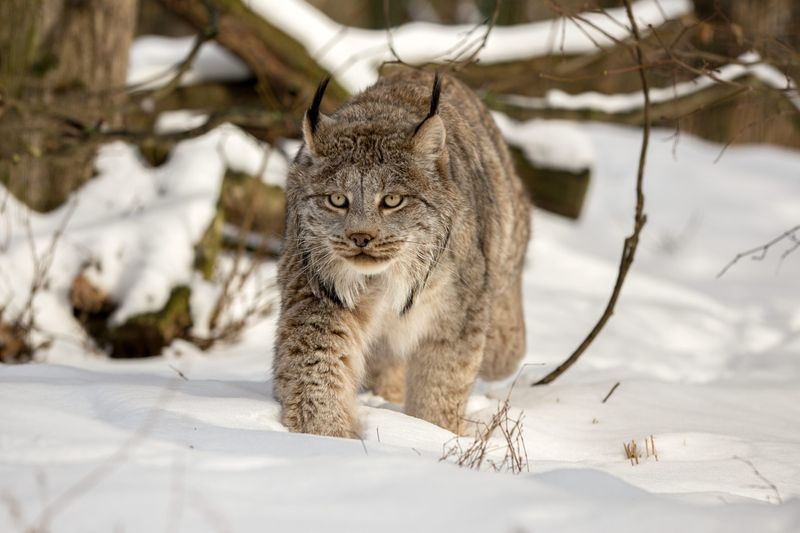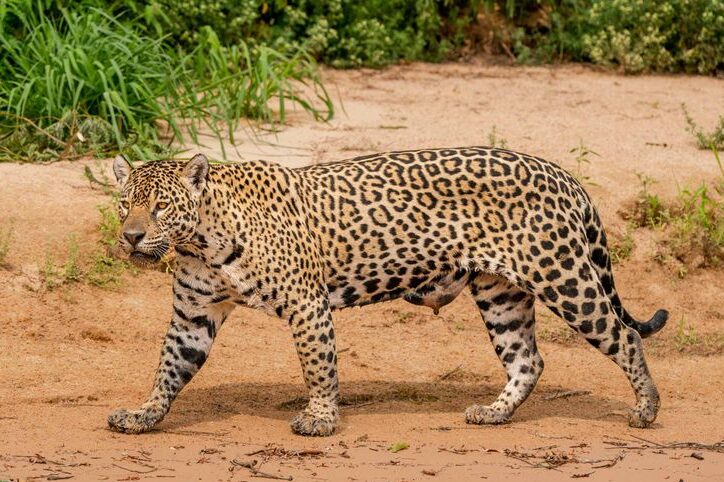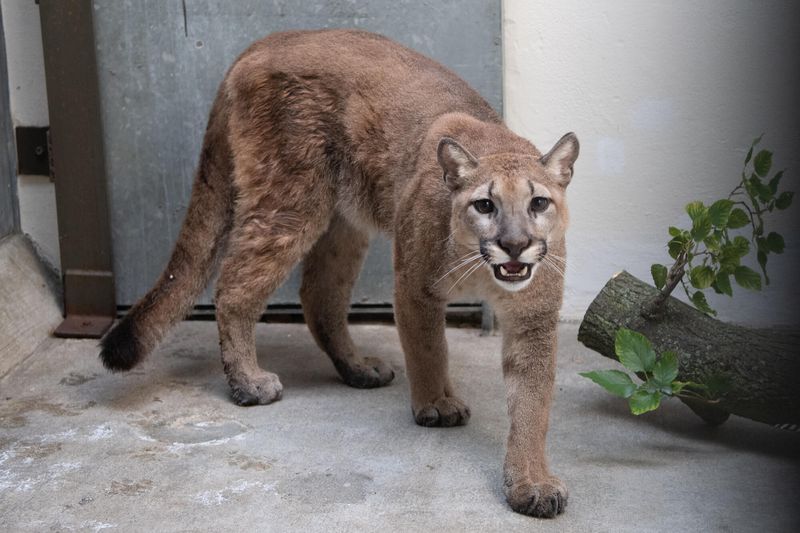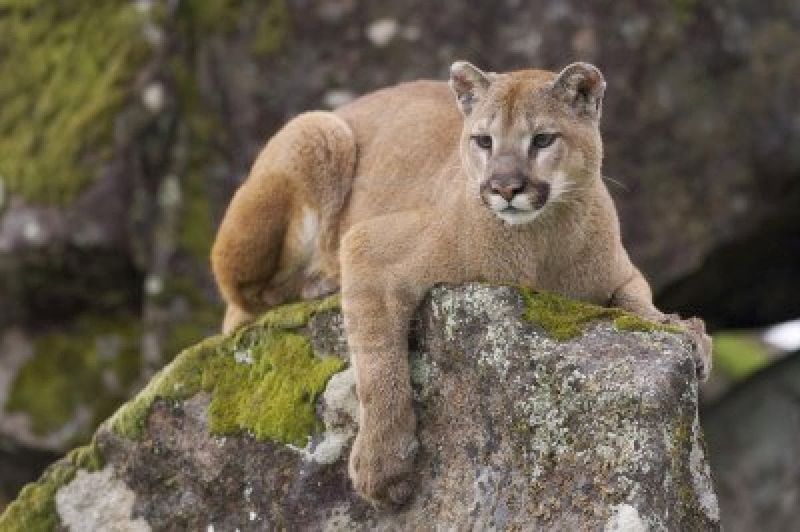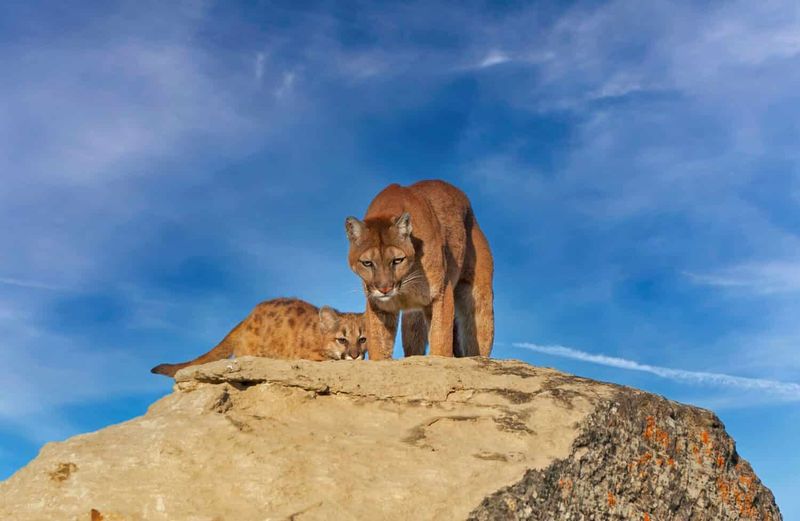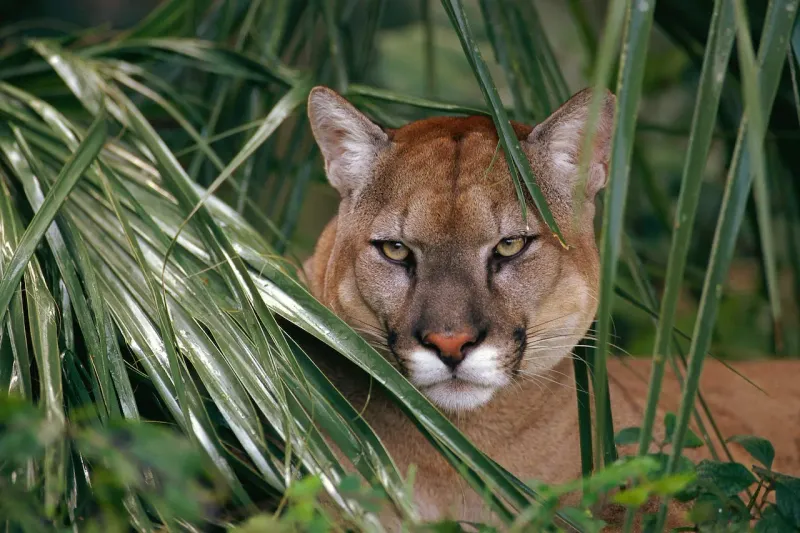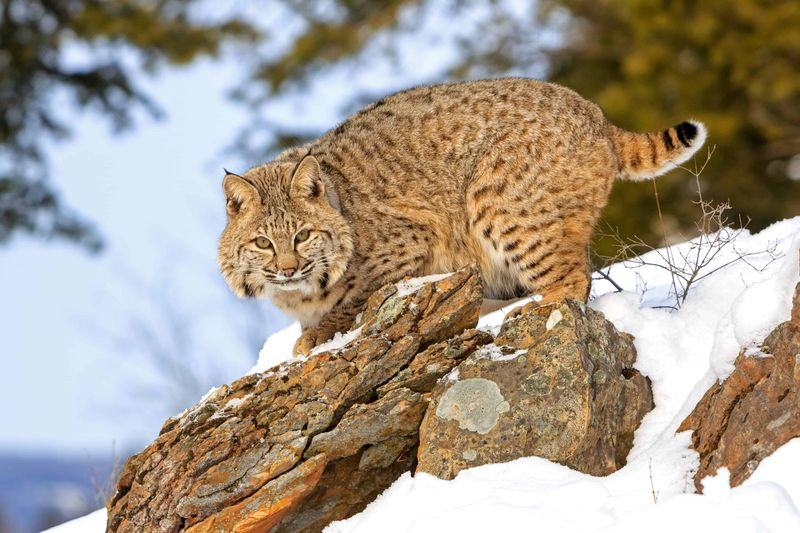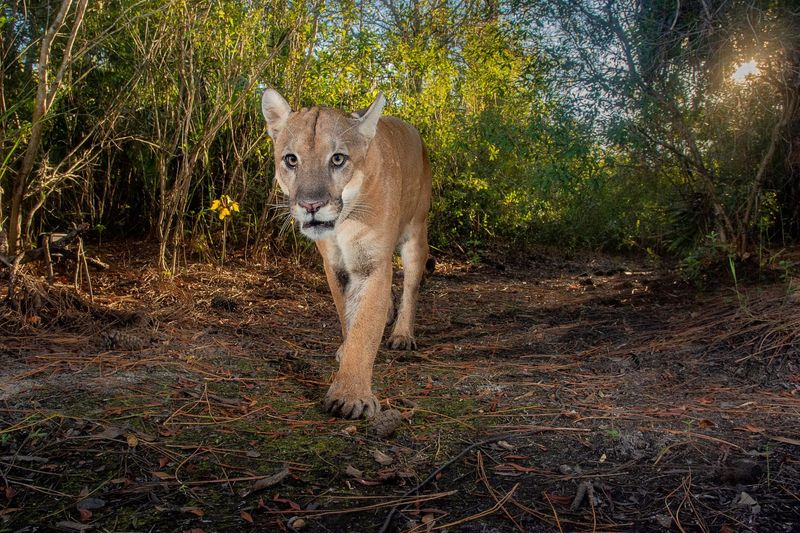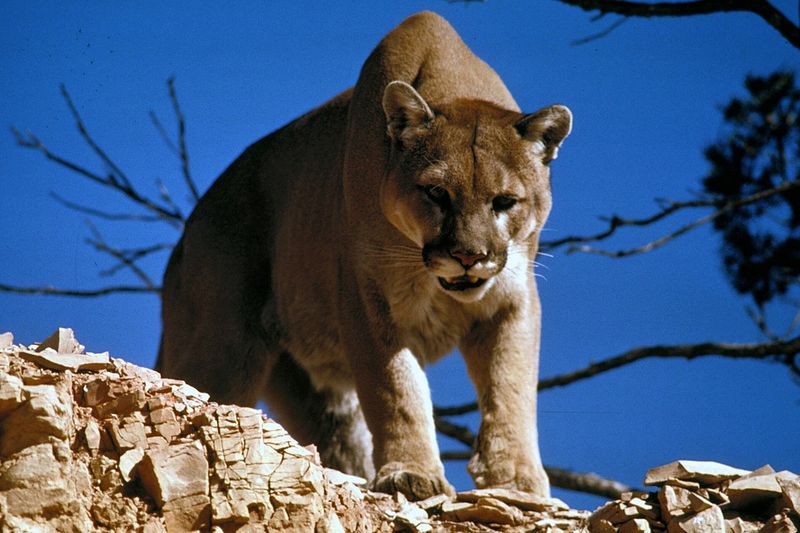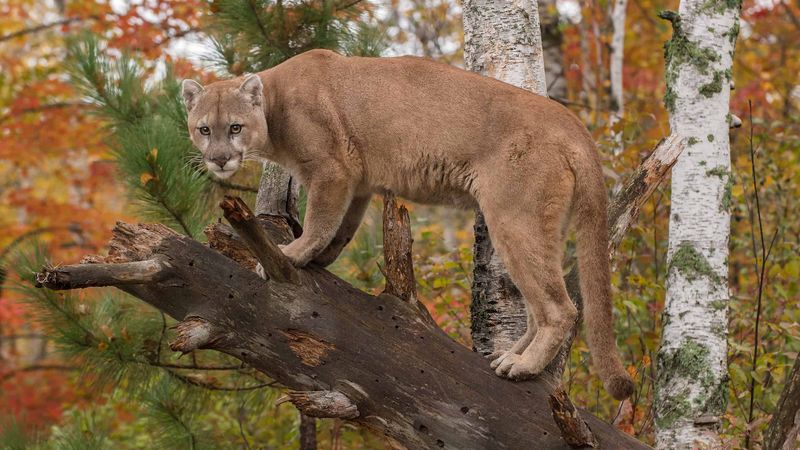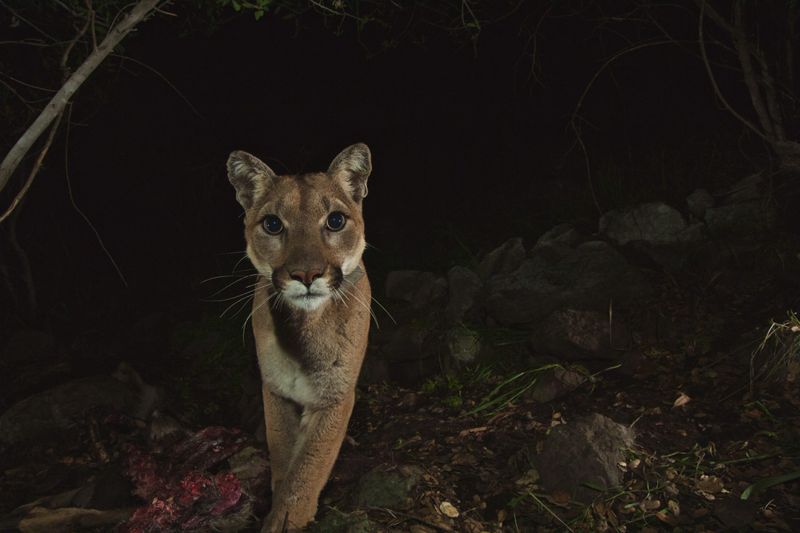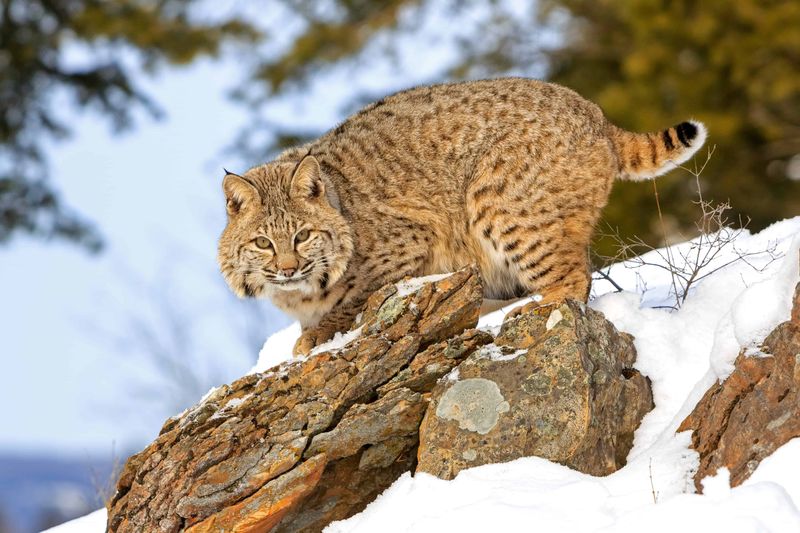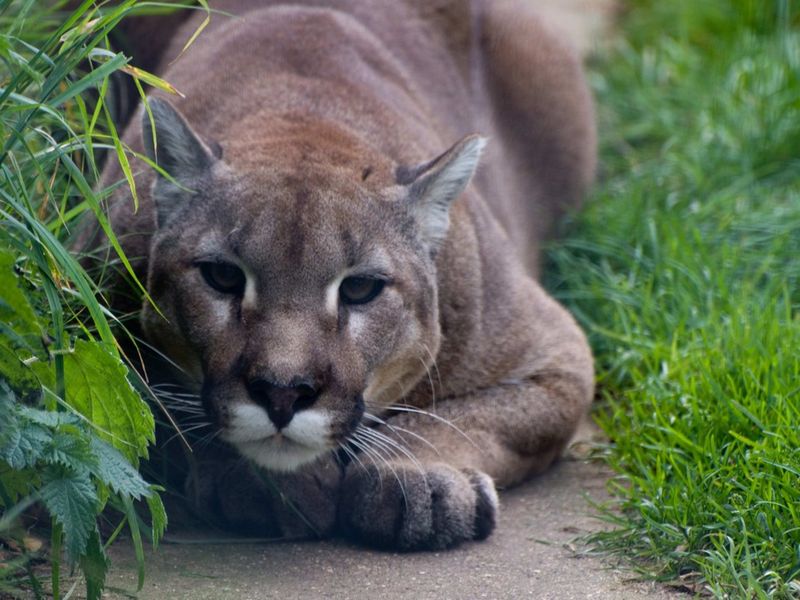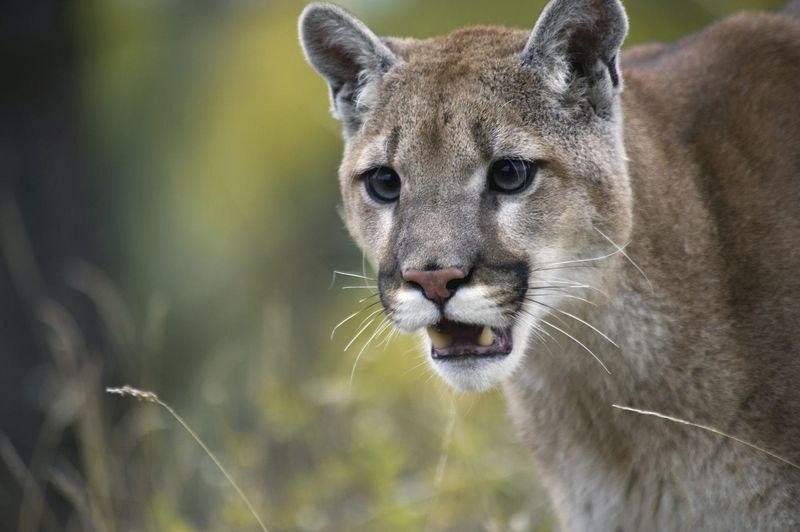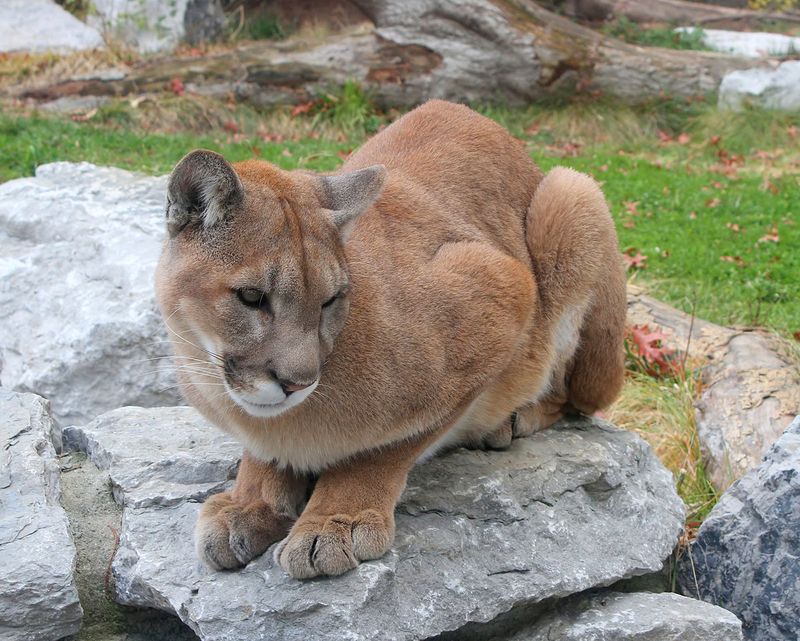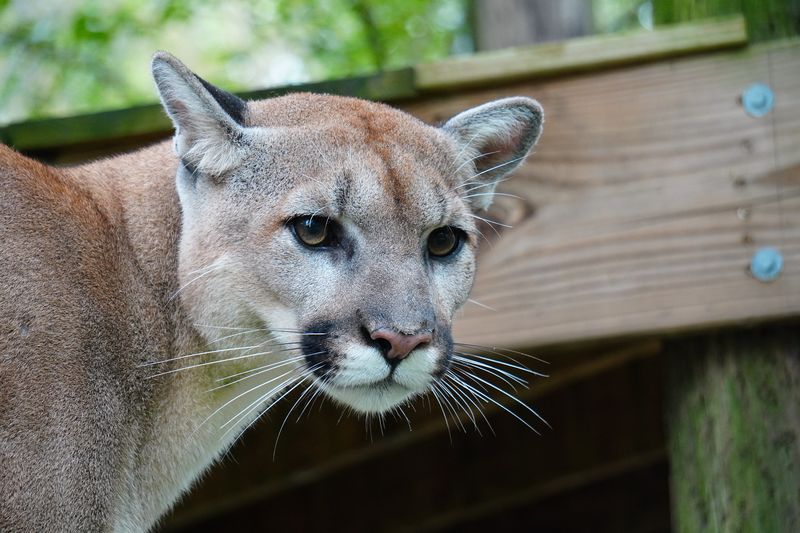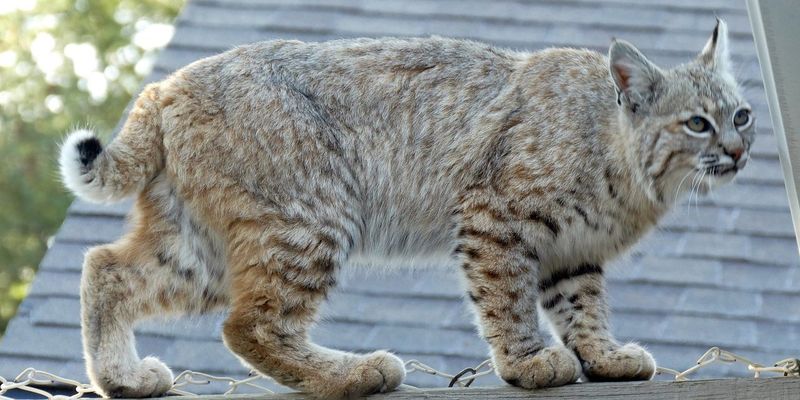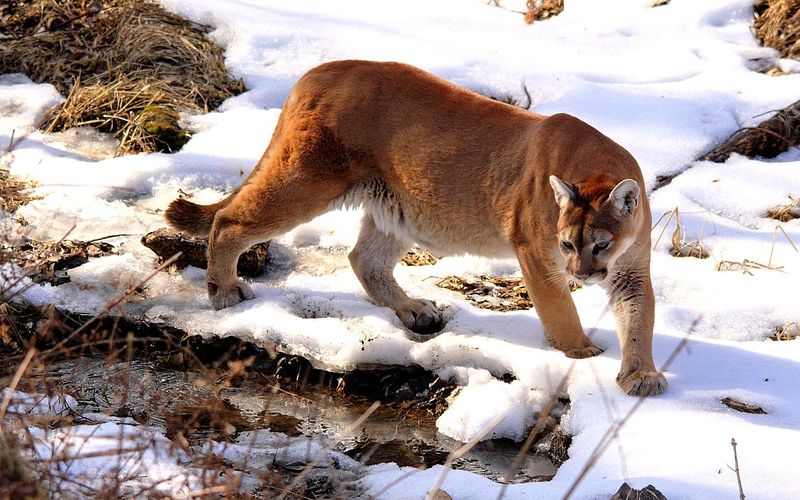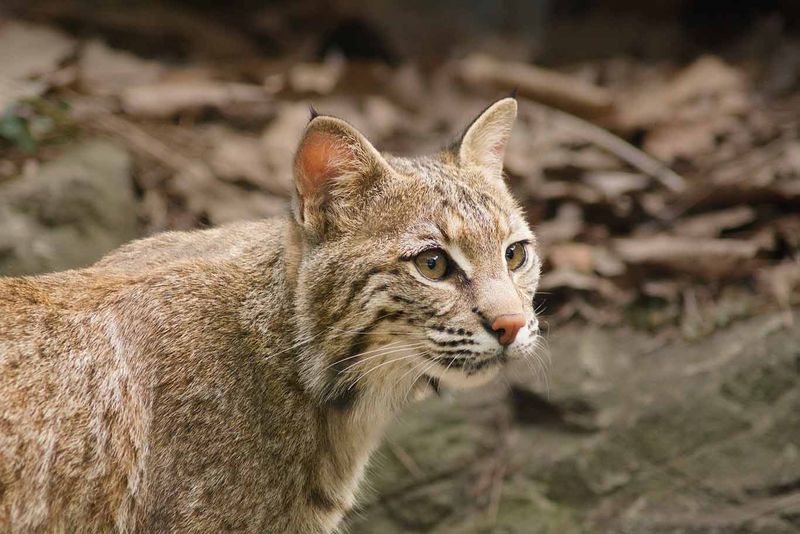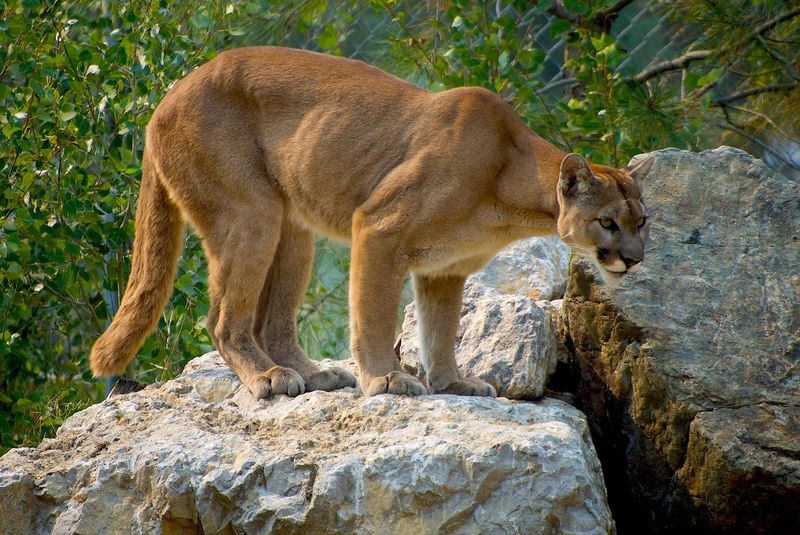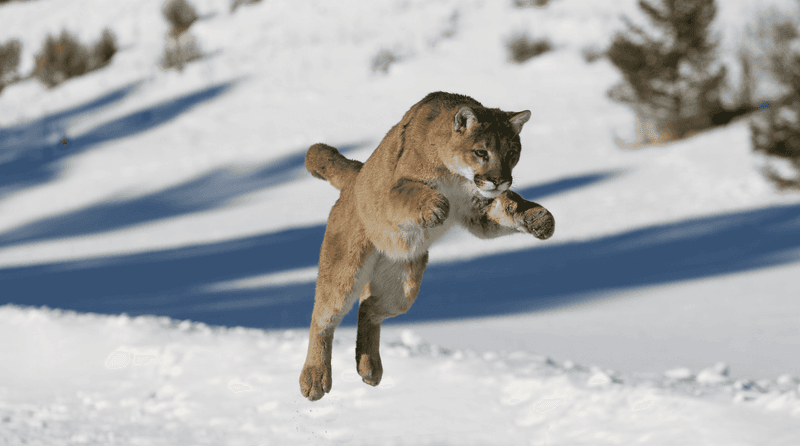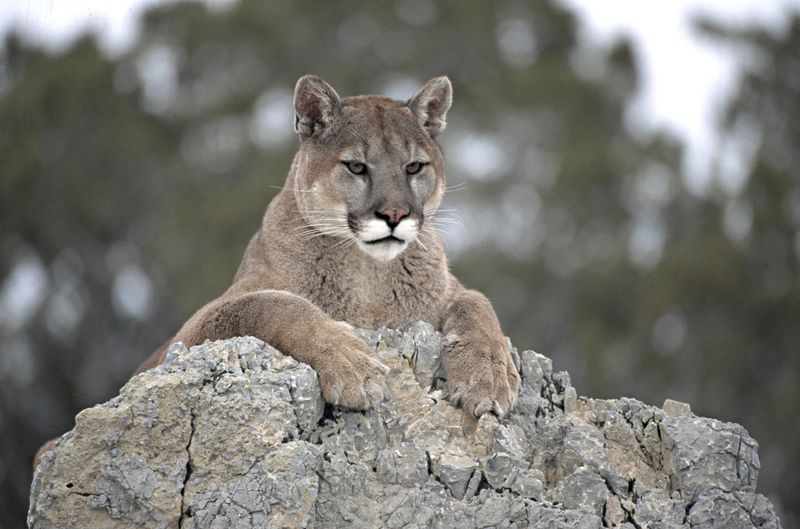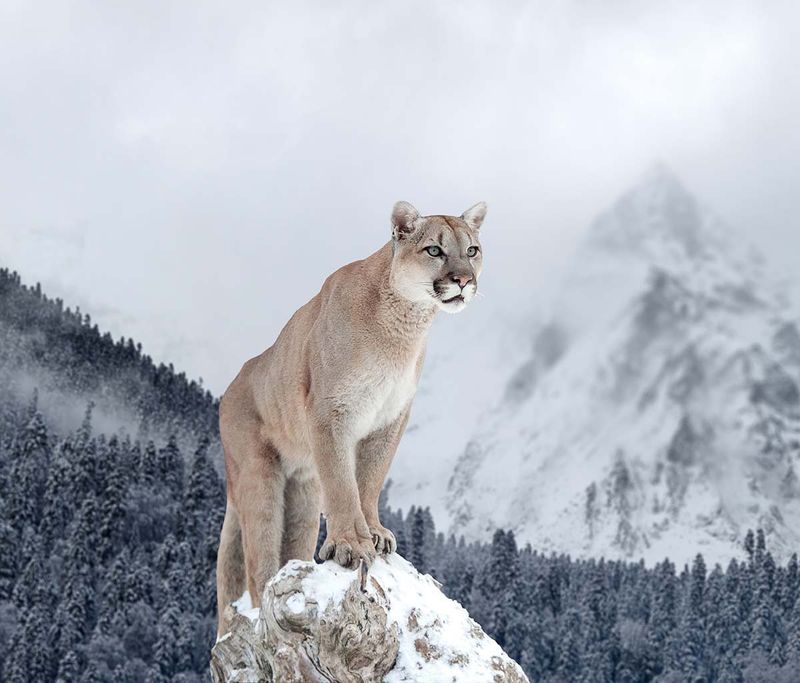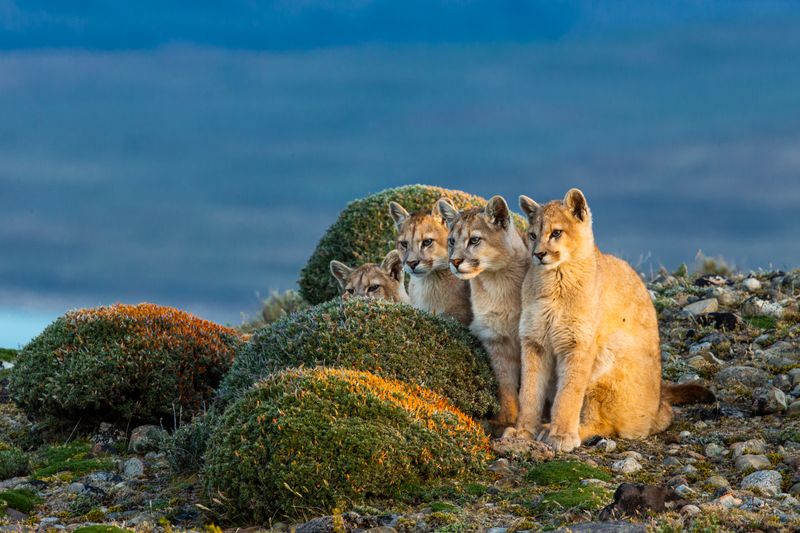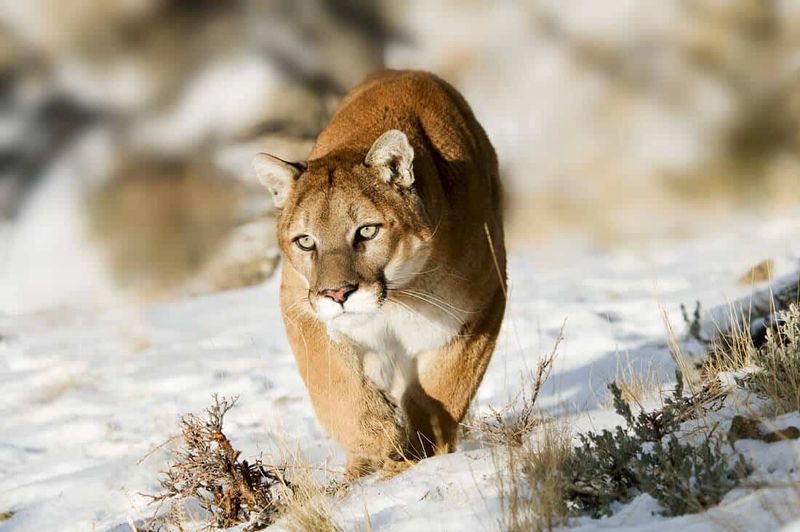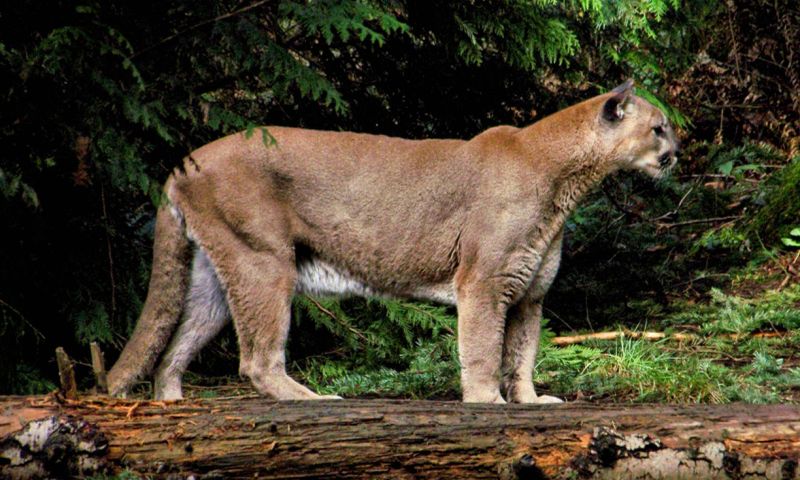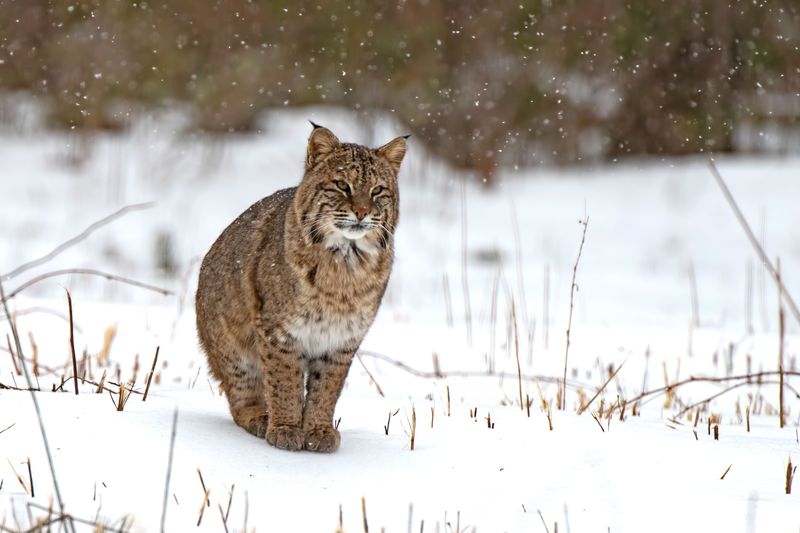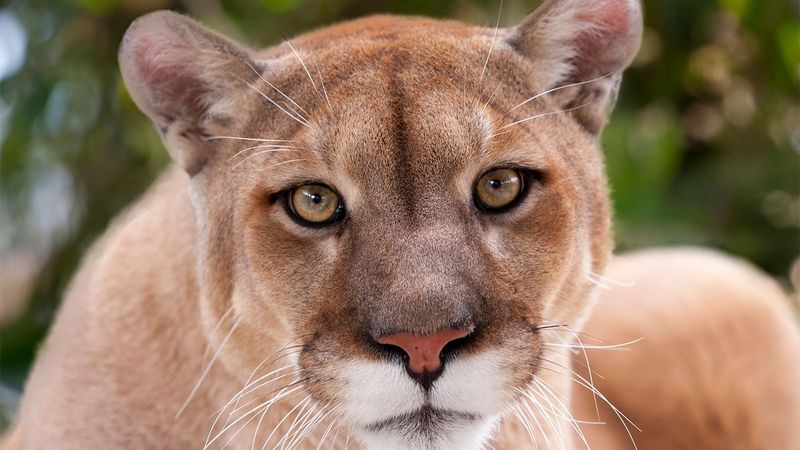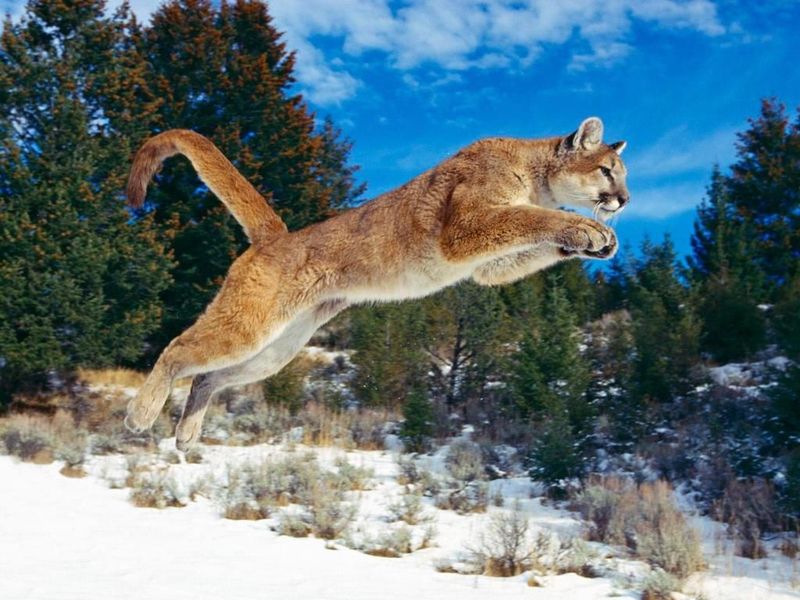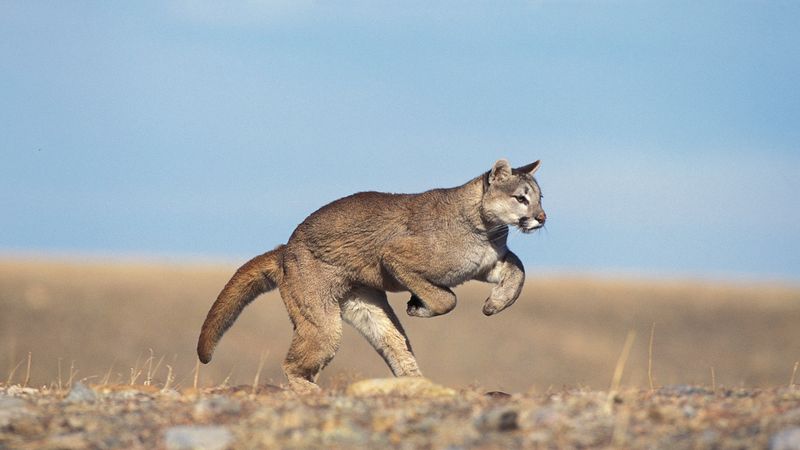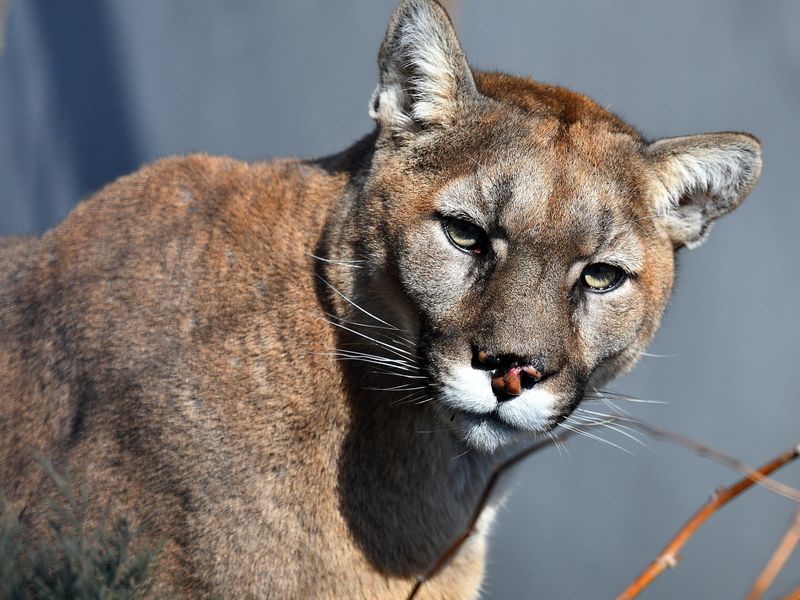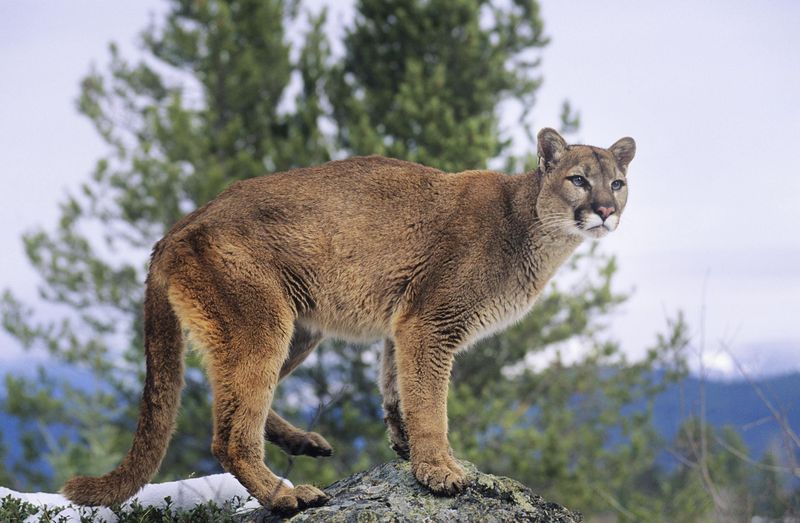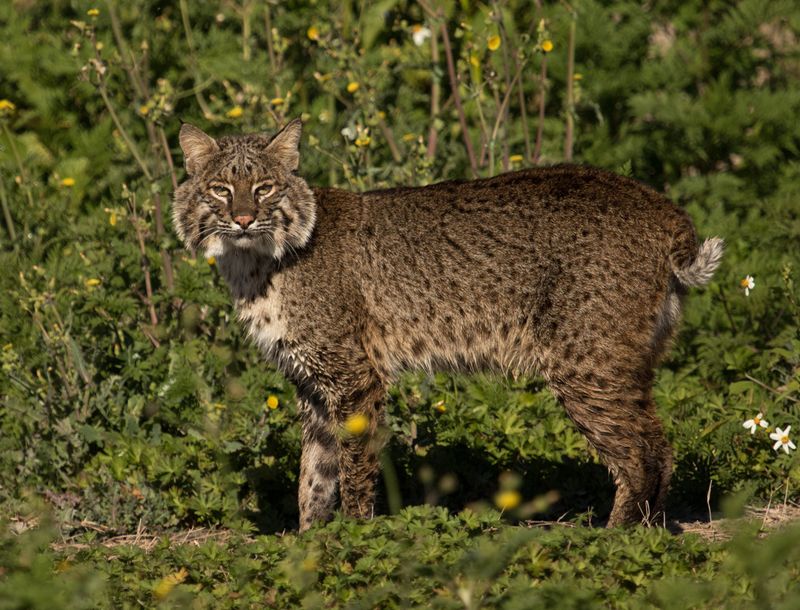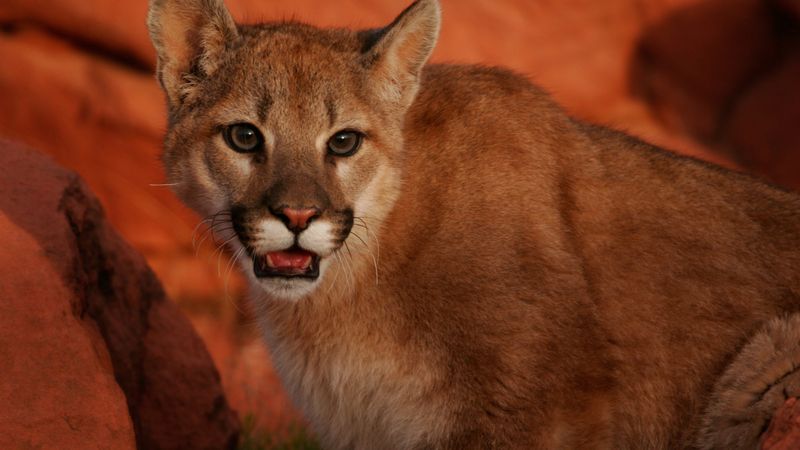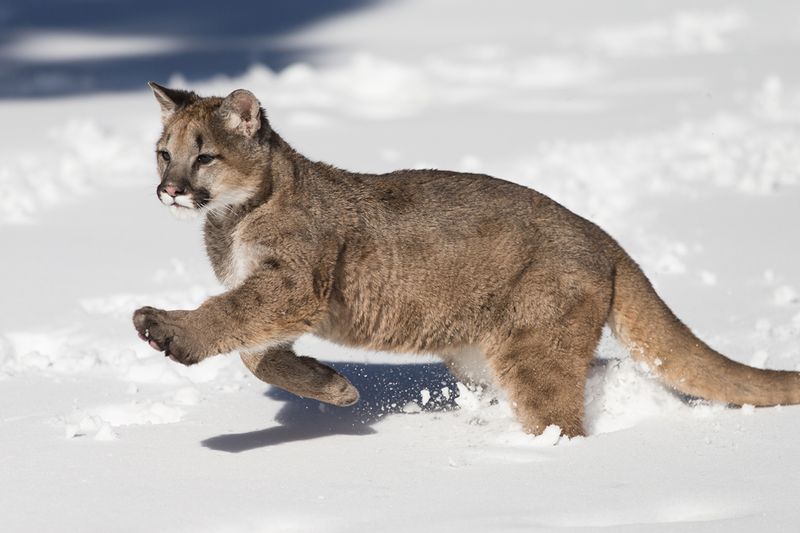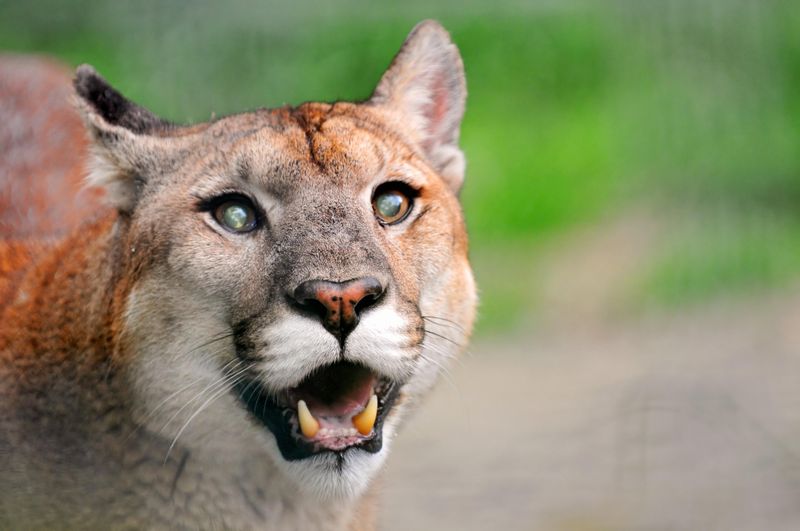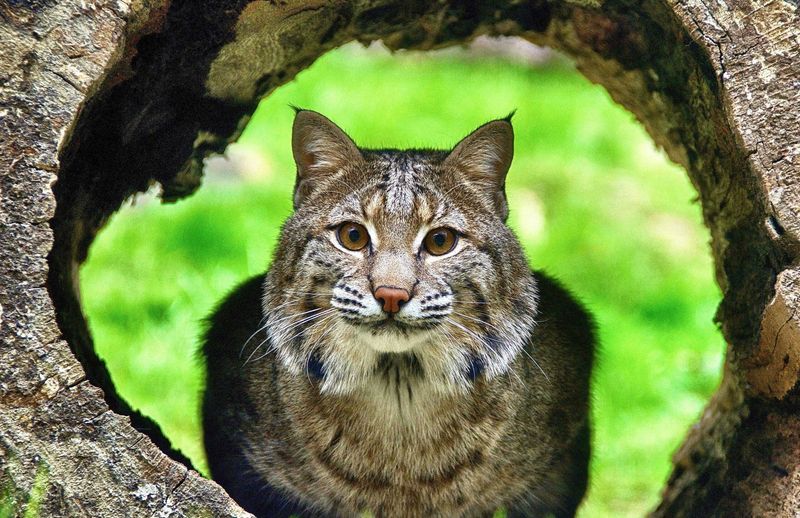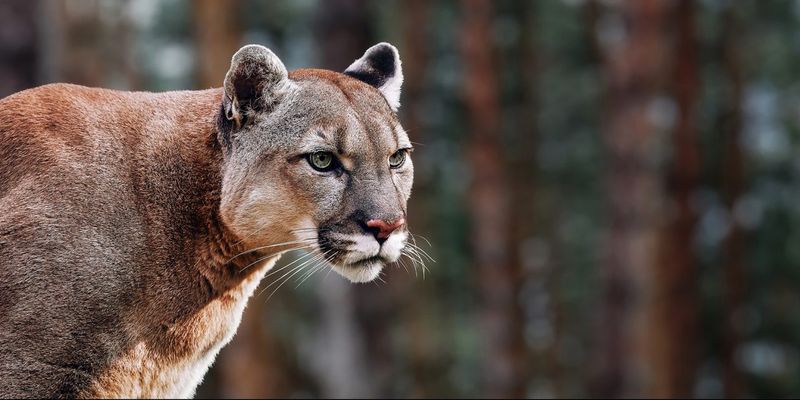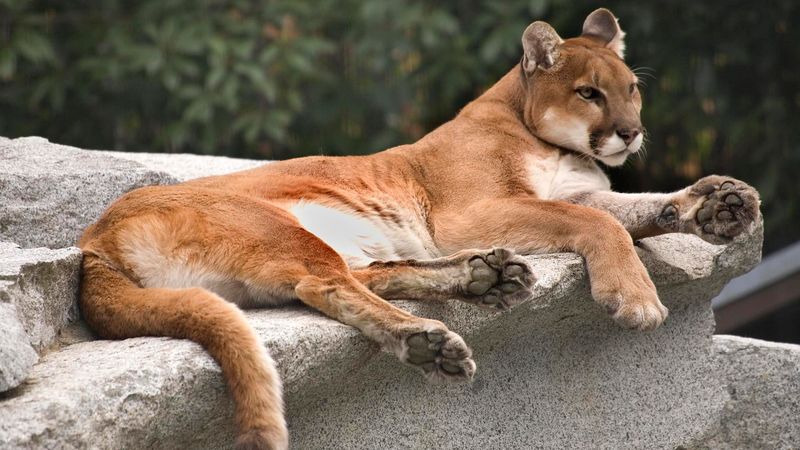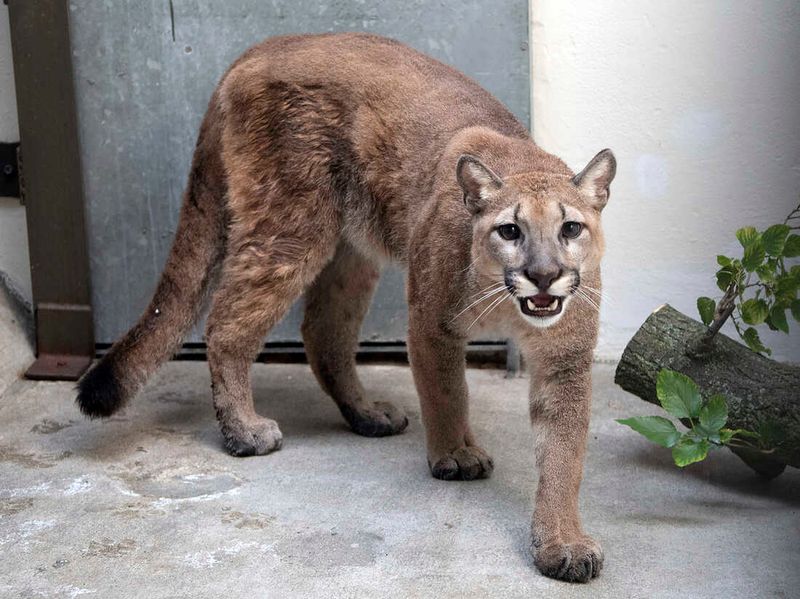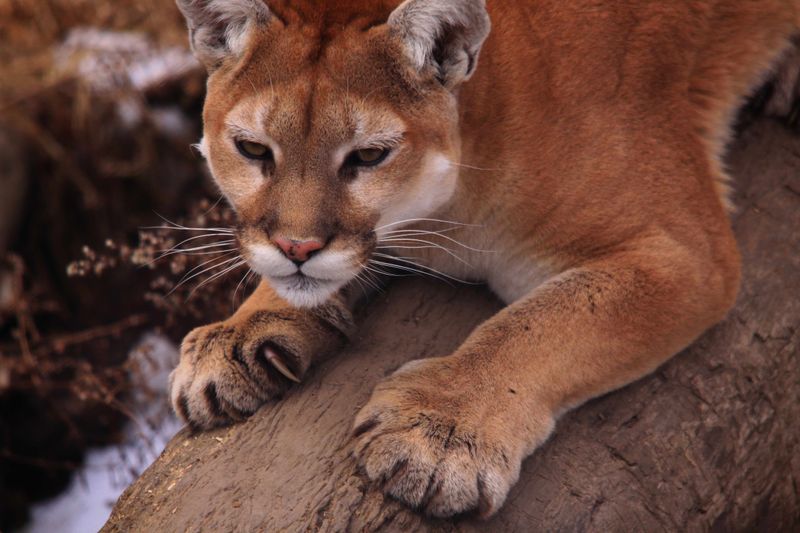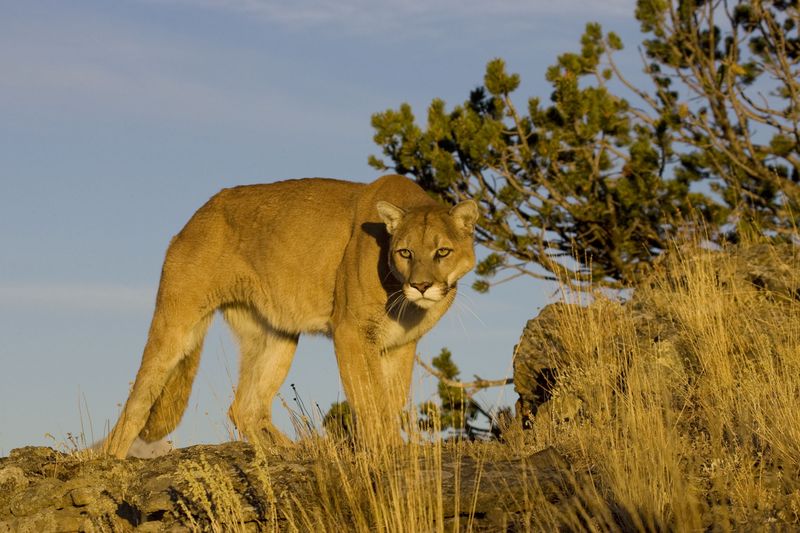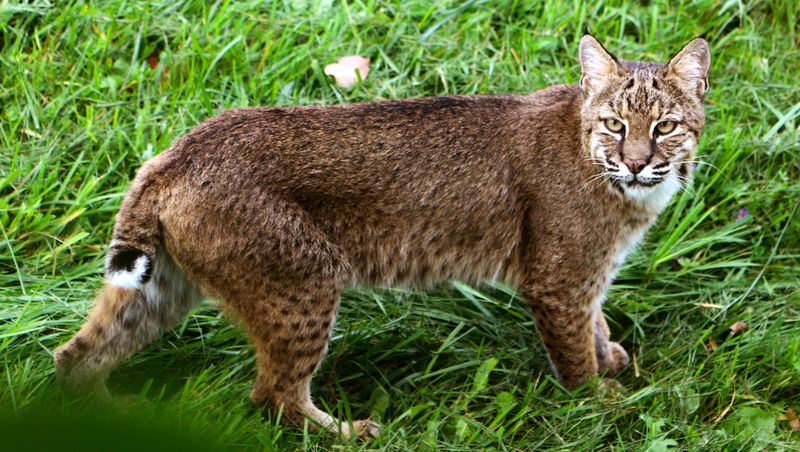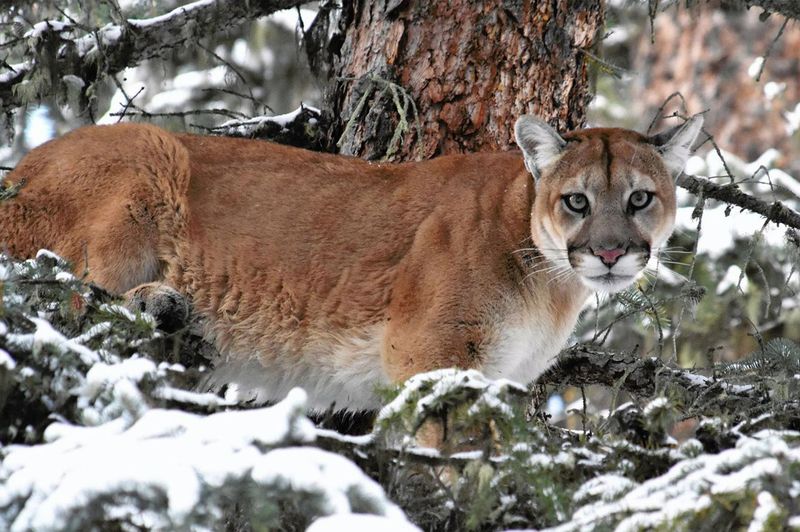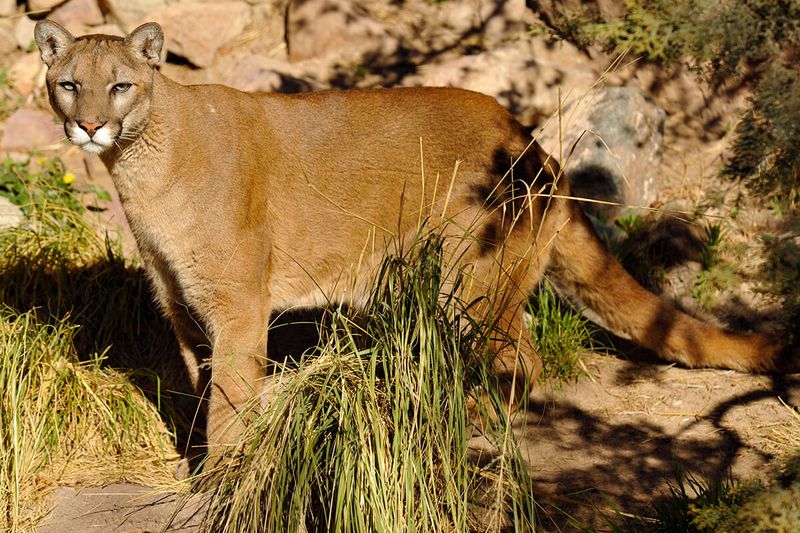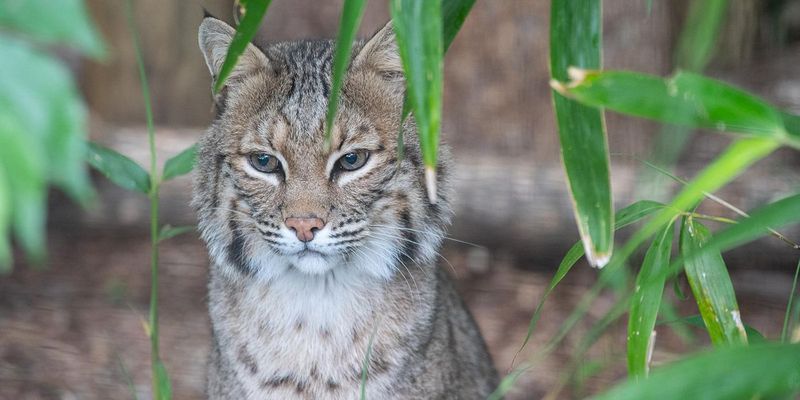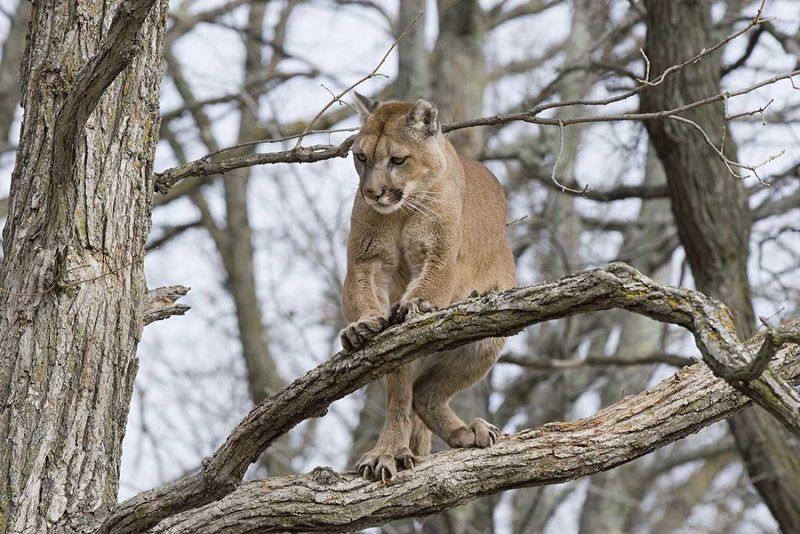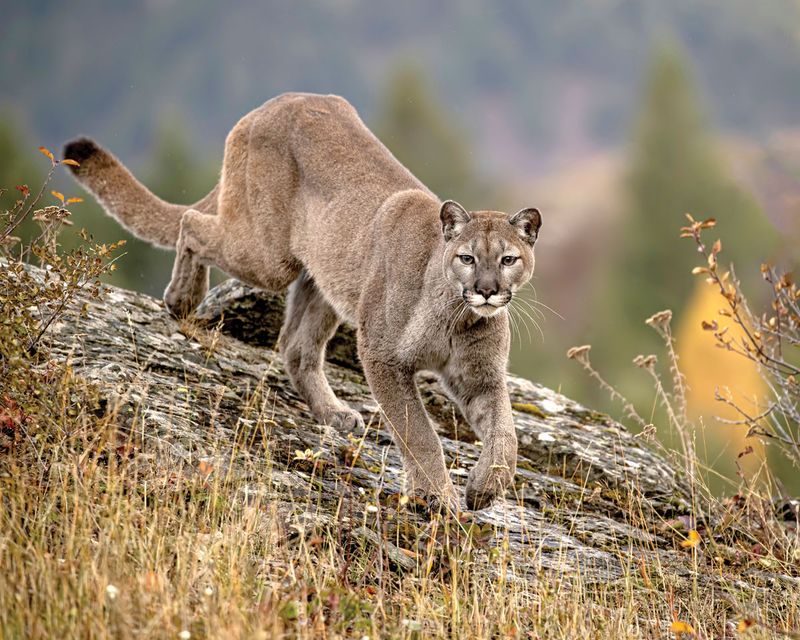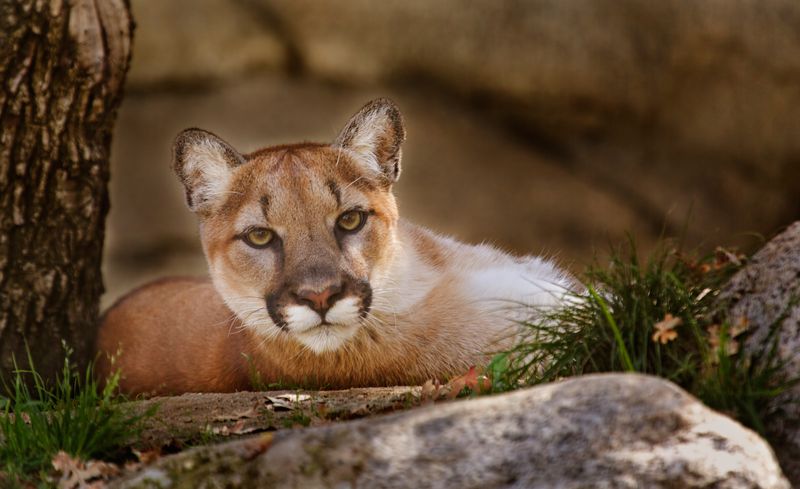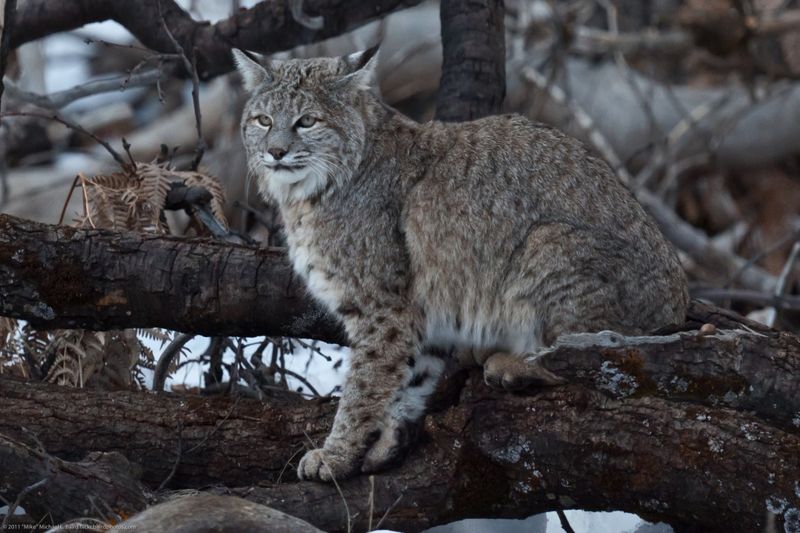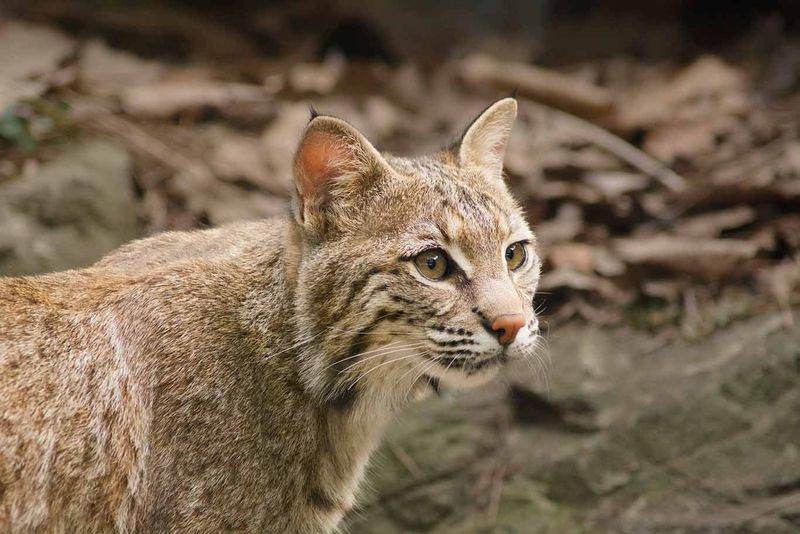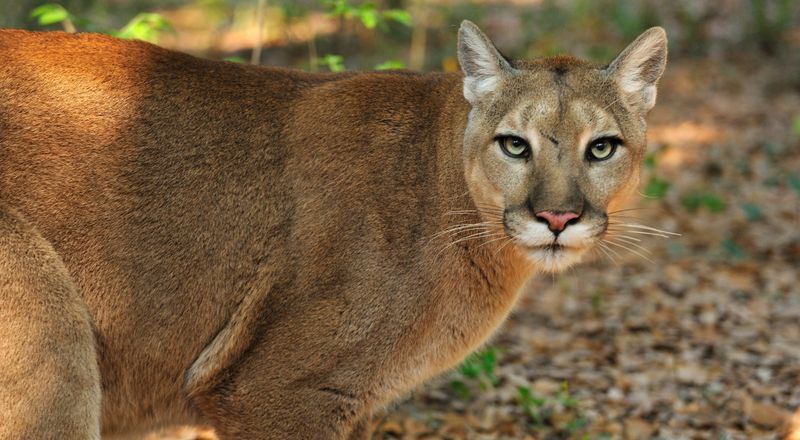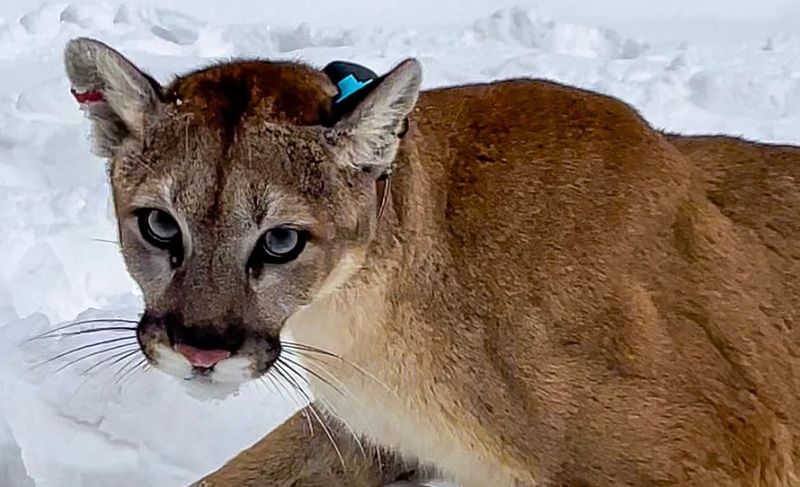📖 Table of Content:
- 1. Alabama – 115 lbs cougar
- 2. Alaska – 38 lbs lynx
- 3. Arizona – 220 lbs jaguar
- 4. Arkansas – 160 lbs cougar
- 5. California – 220 lbs mountain lion
- 6. Colorado – 220 lbs mountain lion
- 7. Connecticut – 140 lbs cougar
- 8. Delaware – 30 lbs bobcat
- 9. Florida – 200 lbs Florida panther
- 10. Georgia – 120 lbs cougar
- 11. Idaho – 200 lbs mountain lion
- 12. Illinois – 150 lbs cougar
- 13. Indiana – 37 lbs bobcat
- 14. Iowa – 120 lbs cougar
- 15. Kansas – 150 lbs cougar
- 16. Kentucky – 125 lbs cougar
- 17. Louisiana – 175 lbs cougar
- 18. Maine – 42 lbs bobcat
- 19. Maryland – 120 lbs cougar
- 20. Massachusetts – 45 lbs bobcat
- 21. Michigan – 160 lbs cougar
- 22. Minnesota – 180 lbs cougar
- 23. Mississippi – 160 lbs cougar
- 24. Missouri – 150 lbs cougar
- 25. Montana – 210 lbs mountain lion
- 26. Nebraska – 205 lbs cougar
- 27. Nevada – 200 lbs mountain lion
- 28. New Hampshire – 40 lbs bobcat
- 29. New Jersey – 150 lbs alleged cougar
- 30. New Mexico – 210 lbs mountain lion
- 31. New York – 125 lbs cougar
- 32. North Carolina – 130 lbs cougar
- 33. North Dakota – 190 lbs cougar
- 34. Ohio – 37 lbs bobcat
- 35. Oklahoma – 180 lbs cougar
- 36. Oregon – 200 lbs mountain lion
- 37. Pennsylvania – 135 lbs alleged cougar
- 38. Rhode Island – 35 lbs bobcat
- 39. South Carolina – 125 lbs cougar
- 40. South Dakota – 210 lbs cougar
- 41. Tennessee – 140 lbs cougar
- 42. Texas – 220 lbs mountain lion
- 43. Utah – 200 lbs mountain lion
- 44. Vermont – 42 lbs bobcat
- 45. Virginia – 120 lbs cougar
- 46. Washington – 190 lbs mountain lion
- 47. West Virginia – 50 lbs bobcat
- 48. Wisconsin – 150 lbs cougar
- 49. Wyoming – 210 lbs mountain lion
- 50. Biggest Ever in the U.S. – 276 lbs mountain lion
- 51. Largest Lynx in the U.S. – 42 lbs
- 52. Largest Bobcat in the U.S. – 50 lbs
- 53. Largest Puma in Recent Years – 225 lbs
- 54. Confirmed Longest Roaming Cougar
Wild cats have long been some of the most elusive and awe-inspiring predators in the United States. From the towering mountains of the West to the dense forests of the East, these majestic felines have roamed for centuries, leaving behind stories of record-breaking sizes and rare sightings. While cougars (also known as mountain lions or pumas) dominate much of the western half of the country, smaller species like bobcats and lynxes thrive in regions with thick woodlands and snowy landscapes. In rare instances, jaguars—typically found in Central and South America—have also been spotted crossing into the southern U.S., adding to the fascinating diversity of wild cats in the country.
Although many of these species have dwindled in numbers due to habitat loss and hunting, occasional sightings and official records have documented some truly massive individuals. Some states, like Florida and Texas, have consistently produced record-setting big cats, while others, like Connecticut and Illinois, have had only a handful of confirmed encounters in the modern era. Whether through camera traps, official wildlife surveys, or accidental human encounters, these extraordinary cats continue to spark interest and debate, especially in regions where their presence is unexpected.
This list highlights the largest wild cats ever spotted in each U.S. state, from verified records to historical accounts and unconfirmed legends. These massive felines range from 30-pound bobcats to cougars exceeding 200 pounds, showcasing the impressive variety of wild cats found across the country. In addition to the largest wild cat in each state, we also include five record-breaking felines that stand out as the biggest ever documented in the U.S. Whether you’re a wildlife enthusiast, a big cat researcher, or just someone fascinated by nature’s giants, this list offers a glimpse into the remarkable world of America’s wild cats.
1. Alabama – 115 lbs cougar
A 115-pound cougar was once recorded in Alabama, though modern sightings remain highly debated. Historically, cougars roamed the state’s forests, but their numbers declined rapidly due to habitat destruction and hunting. This particular specimen, recorded in the 19th or early 20th century, is among the largest ever documented in the region. No confirmed wild cougars exist in Alabama today, though occasional reports still surface. Wildlife experts believe these sightings are either misidentified animals or transient individuals from western populations. Despite their historical presence, Alabama’s official wildlife records list cougars as extirpated. However, with growing conservation efforts, some believe they may one day return.
2. Alaska – 38 lbs lynx
Among Alaska’s wild felines, a 38-pound lynx holds the record as the largest documented in the state. Unlike other regions that host cougars, Alaska’s frigid landscapes are dominated by the Canada lynx, a stealthy predator adept at navigating deep snow. This record-breaking lynx was found in the dense boreal forests, where the species thrives on snowshoe hares. Due to their thick fur and large paws, these cats are well-adapted to cold climates. Although lynx populations fluctuate in response to prey availability, they remain a stable and essential part of Alaska’s ecosystem. While no cougars are known to reside in the state, some speculate that climate changes could eventually expand their range northward. For now, the Canada lynx remains Alaska’s most formidable wild cat.
3. Arizona – 220 lbs jaguar
Towering over other wild cats, “El Jefe,” a 220-pound jaguar, became famous when spotted in Arizona in 2016. This massive feline roamed the Santa Rita Mountains and was one of the few jaguars confirmed north of the U.S.-Mexico border. Unlike cougars, jaguars are a rarity in the U.S., primarily inhabiting tropical forests of Central and South America. Conservationists captured stunning footage of El Jefe prowling through the rugged landscape, fueling discussions about preserving jaguar corridors. Since then, no other jaguar has been definitively documented in Arizona, though hopeful researchers continue to monitor the area. With ongoing habitat restoration, some believe jaguars could establish a small breeding population in the Southwest. El Jefe’s legacy remains one of the most remarkable big cat sightings in American history.
4. Arkansas – 160 lbs cougar
Confirmed in 2011, a 160-pound cougar stunned Arkansas wildlife officials when it appeared after more than a century of presumed local extinction. Once a common predator in the Ozarks, cougars disappeared from the region due to hunting and human encroachment. This individual, however, provided proof that these elusive cats still traverse the state. DNA analysis suggested the animal had migrated from western populations, likely traveling hundreds of miles in search of territory. The sighting sparked renewed interest in whether cougars are recolonizing the eastern United States. Since then, additional reports have surfaced, though no evidence of a breeding population exists. Arkansas remains a state where cougars are officially classified as extinct, despite occasional confirmations of lone wanderers.
5. California – 220 lbs mountain lion
In the mountains of California, a 220-pound mountain lion set the record as the largest documented in the state. These apex predators thrive in the rugged terrain of the Sierra Nevada and the coastal ranges, where they hunt deer and smaller mammals. The massive individual was captured by wildlife researchers studying the impact of urban encroachment on big cat populations. California’s mountain lions are among the most well-studied in the country, with tracking collars providing invaluable data on their behavior. Despite their adaptability, habitat loss and vehicle collisions pose major threats to their survival. Protected by law, these animals continue to navigate the ever-shrinking wild spaces of the state. Large males like this one are becoming increasingly rare, making conservation efforts even more critical.
6. Colorado – 220 lbs mountain lion
Documented in 2020, a 220-pound mountain lion in Colorado solidified its place as one of the state’s largest recorded wild cats. Colorado is home to a healthy cougar population, with vast mountain ranges offering prime habitat. This particular individual was caught on a trail camera near a remote wilderness area, showcasing its sheer size and muscular build. Wildlife officials believe it was a dominant male, capable of covering vast territories in search of food and mates. Cougars in Colorado play a crucial role in maintaining ecological balance by controlling deer populations. Human encounters remain rare, but sightings have increased in recent years due to expanding human settlements. While the species remains stable in the state, continued conservation efforts are necessary to ensure their long-term survival.
7. Connecticut – 140 lbs cougar
In 2011, Connecticut witnessed the confirmed sighting of a 140 lbs cougar, an event that intrigued wildlife experts and residents. This cougar, genetically traced back to South Dakota, traveled an incredible distance before reaching Connecticut. Such journeys highlight the adaptability and resilience of these creatures, capable of traversing vast territories. The sighting serves as a reminder of the interconnectedness of ecosystems and the importance of wildlife corridors. As cougars reclaim territories, understanding their needs and promoting coexistence becomes crucial for preserving biodiversity and fostering a harmonious relationship between humans and wildlife.
8. Delaware – 30 lbs bobcat
With no confirmed cougar populations, Delaware’s largest recorded wild cat is a 30-pound bobcat. While bobcats were once rare in the state, their numbers have been increasing in recent years. This particular individual was documented by a wildlife camera near a protected woodland area. Bobcats in Delaware tend to be smaller than their western counterparts due to differences in habitat and prey availability. Unlike mountain lions, bobcats are far more adaptable and can thrive in fragmented landscapes. Their resurgence has been welcomed by conservationists, as it indicates healthy ecosystems. Although cougars remain absent, bobcats serve as the dominant wild feline in Delaware’s forests and marshlands.
9. Florida – 200 lbs Florida panther
The Florida panther is a symbol of the state’s rich biodiversity, with the largest verified specimen weighing an impressive 200 lbs. These majestic creatures roam the Everglades, playing a critical role in the ecosystem by regulating prey populations. Unfortunately, their numbers have dwindled due to habitat loss and human encroachment, making conservation efforts vital. Initiatives to protect their natural habitats and create wildlife corridors are essential for ensuring their survival. The Florida panther’s story highlights the importance of preserving our natural world, inspiring efforts to safeguard these incredible animals for future generations.
10. Georgia – 120 lbs cougar
A historic 120-pound cougar from Georgia once roamed the state before the species was declared locally extinct. Cougars were common in the southeastern U.S. until widespread hunting and habitat destruction led to their disappearance. Occasional reports of sightings persist, though none have been confirmed. Some believe these reports could be misidentified bobcats, escaped exotic pets, or transient individuals from western populations. Despite their historical absence, the idea of a reestablished cougar population in Georgia remains debated. With increasing reforestation and conservation efforts, some experts argue that Georgia could support mountain lions again. Until then, the state’s largest wild cats are its thriving population of bobcats, which continue to expand.
11. Idaho – 200 lbs mountain lion
Idaho’s largest recorded wild cat was a 200-pound mountain lion, a formidable predator in the state’s rugged wilderness. With vast forests and mountainous terrain, Idaho provides an ideal habitat for cougars. This massive male was captured and studied as part of ongoing research into mountain lion behavior. Known for their stealth and agility, Idaho’s cougars help regulate deer populations and maintain ecosystem balance. While sightings are rare due to their elusive nature, evidence of their presence is found in tracks, trail cameras, and occasional livestock predation. Hunting regulations have helped manage populations, ensuring their continued presence in the state. This 200-pound individual remains one of Idaho’s most impressive wild feline specimens.
12. Illinois – 150 lbs cougar
Illinois recorded a 150-pound cougar in 2013, marking one of the state’s few confirmed sightings in modern times. Historically, mountain lions roamed Illinois, but hunting and habitat loss led to their disappearance. This individual was believed to have migrated from western populations, traveling hundreds of miles in search of territory. The sighting reignited debates about the return of cougars to the Midwest, though no established breeding population exists. Despite occasional reports, most sightings remain unverified, leaving Illinois without a resident cougar population. Wildlife officials emphasize the importance of distinguishing between true wild cougars and escaped exotic pets. Though rare, cases like this show that cougars are capable of crossing state lines and reclaiming former territories.
13. Indiana – 37 lbs bobcat
Indiana’s largest recorded wild cat was a 37-pound bobcat, the state’s dominant feline predator. Once rare in Indiana, bobcats have made a strong comeback due to legal protections and habitat recovery. This particular bobcat was captured and weighed as part of a wildlife study in southern Indiana. Preferring dense forests and brush-covered areas, these stealthy hunters primarily prey on rabbits, rodents, and small deer. Despite their increasing numbers, bobcats are rarely seen due to their secretive nature. Indiana has no confirmed cougar population, though occasional reports surface. For now, the bobcat remains the largest wild cat naturally occurring in the state.
14. Iowa – 120 lbs cougar
In Iowa, a 120-pound cougar was confirmed in 2020, marking one of the state’s largest recorded mountain lions. While Iowa lacks a resident cougar population, transient individuals occasionally appear. This particular cat was captured on a trail camera in a remote wooded area, providing clear evidence of its presence. Experts believe it traveled from a western state, as cougars frequently disperse in search of new territories. Iowa’s landscape, rich with deer and other prey, could theoretically support a cougar population if migration continues. However, due to human development and limited forested areas, long-term survival remains uncertain. Wildlife officials continue to monitor sightings, ensuring public awareness and conservation efforts.
15. Kansas – 150 lbs cougar
In 2007, Kansas confirmed the sighting of a 150 lbs cougar, marking a notable event for the state’s wildlife. These powerful predators are essential for maintaining ecological balance, controlling deer and smaller prey populations. Cougars are highly adaptable, able to thrive in diverse environments, from prairies to woodlands. For those interested in wildlife conservation, understanding cougar behavior and habitat needs is crucial. Promoting habitat preservation and connectivity can help ensure the continued presence of these majestic animals, allowing them to play their vital role in the ecosystem while coexisting with human communities.
16. Kentucky – 125 lbs cougar
In 2014, Kentucky witnessed the rare sighting of a 125 lbs cougar, an event that sparked interest among wildlife enthusiasts and conservationists. This cougar, unfortunately shot by officials, highlighted the challenges of human-wildlife interactions. Despite this, the sighting underscores the potential for cougars to return to areas they once inhabited. Promoting habitat preservation and understanding cougar behavior are essential for fostering coexistence. Efforts to educate the public about these majestic animals can help prevent conflicts and support the natural rewilding of regions like Kentucky, allowing these predators to thrive once more.
17. Louisiana – 175 lbs cougar
Louisiana’s largest recorded wild cat was a 175-pound cougar confirmed in 2011, the first in over a century. Mountain lions once thrived in Louisiana before being wiped out due to hunting and habitat destruction. This individual was captured on a trail camera and later verified through genetic testing. Experts determined it had likely traveled from western states, covering hundreds of miles undetected. While Louisiana lacks a breeding population, the state’s abundant wetlands and forests could theoretically support cougars. Bobcats remain the primary wild feline in Louisiana, adapting well to various environments. Despite this sighting, the official status of cougars in Louisiana remains “extirpated.”
18. Maine – 42 lbs bobcat
Maine’s largest recorded wild cat is the bobcat, with individuals weighing up to 42 lbs. These agile predators are well-adapted to the dense forests and rugged terrain of the state. Bobcats are primarily nocturnal and elusive, making them a rare sight for wildlife enthusiasts. Their adaptability allows them to thrive in various environments, from woodlands to mountainous areas. For those interested in observing Maine’s wildlife, understanding bobcat behavior and habitat preferences can enhance the chances of spotting these fascinating felines in their natural settings, contributing to a greater appreciation of the state’s rich biodiversity.
19. Maryland – 120 lbs cougar
Maryland’s largest recorded wild cat was a 120-pound cougar, though modern sightings remain unconfirmed. Historically, mountain lions roamed Maryland, but hunting led to their disappearance. Occasional reports still surface, but wildlife officials have found no definitive proof of a resident population. The most recent verified cougar in Maryland was a roadkill specimen in the early 1900s. Today, bobcats represent the largest confirmed wild feline, though they are smaller than their western counterparts. Despite the lack of cougars, Maryland’s forests could theoretically support their return. Until evidence proves otherwise, cougars remain classified as extinct in the state.
20. Massachusetts – 45 lbs bobcat
Massachusetts has recorded a 45-pound bobcat as its largest confirmed wild feline. Once rare in the state, bobcats have rebounded due to conservation efforts. This particular bobcat was captured and tagged in western Massachusetts, where populations are strongest. Preferring forests and rocky terrain, bobcats hunt a variety of small prey, including rabbits and birds. While some residents claim to see cougars, no official evidence supports these sightings. The possibility of a transient cougar passing through Massachusetts remains, though no proof exists. For now, bobcats are the dominant wild feline species in the state.
21. Michigan – 160 lbs cougar
A 160-pound cougar in Michigan, recorded in the Upper Peninsula in 2019, was one of the state’s most significant wild cat confirmations. Michigan has seen a growing number of confirmed cougar sightings in recent years. DNA analysis of the 2019 cougar linked it to western populations, indicating natural migration. Michigan’s dense forests and abundant deer make it a suitable environment for mountain lions. However, no breeding population has been confirmed, meaning sightings remain sporadic. Bobcats are the only established wild cat species, with populations spread throughout the state. While cougars occasionally appear, their long-term presence remains uncertain.
22. Minnesota – 180 lbs cougar
Minnesota’s expansive wilderness is home to the formidable cougar, with the largest recorded at 180 lbs. These powerful predators play a vital role in maintaining ecological balance, controlling deer and smaller prey populations. Cougars are highly adaptable, able to thrive in various environments, from dense forests to open prairies. For those interested in wildlife conservation, understanding cougar behavior and habitat needs is crucial. Promoting habitat preservation and connectivity can help ensure the continued presence of these majestic animals, allowing them to play their vital role in the ecosystem while coexisting with human communities.
23. Mississippi – 160 lbs cougar
Roaming through Missouri’s wilderness, a 150-pound cougar was confirmed in 2022, marking one of the largest recorded in the state. Although Missouri lacks a resident breeding population, these big cats occasionally migrate from western territories. This particular individual was captured on a trail camera and later verified by the Missouri Department of Conservation. Cougars in Missouri are often young males traveling in search of new territory, as they can cover hundreds of miles. Despite increased sightings, no evidence suggests a sustainable breeding group exists in the state. Bobcats, on the other hand, are well-established and continue to thrive across Missouri’s forests. While cougars may not be permanent residents, their occasional presence proves their ability to traverse great distances.
24. Missouri – 150 lbs cougar
Roaming through Missouri’s wilderness, a 150-pound cougar was confirmed in 2022, marking one of the largest recorded in the state. Although Missouri lacks a resident breeding population, these big cats occasionally migrate from western territories. This particular individual was captured on a trail camera and later verified by the Missouri Department of Conservation. Cougars in Missouri are often young males traveling in search of new territory, as they can cover hundreds of miles. Despite increased sightings, no evidence suggests a sustainable breeding group exists in the state. Bobcats, on the other hand, are well-established and continue to thrive across Missouri’s forests. While cougars may not be permanent residents, their occasional presence proves their ability to traverse great distances.
25. Montana – 210 lbs mountain lion
Montana’s majestic terrains are home to the mighty mountain lion, with the largest verified individual weighing 210 lbs. These powerful predators are vital for maintaining ecological balance, controlling prey populations and supporting biodiversity. Known for their elusive nature, mountain lions are rarely seen, preferring to live in solitude among the mountains and forests. Their presence in Montana is a testament to the state’s rich biodiversity and ongoing conservation efforts. Protecting their natural habitats ensures that these magnificent creatures continue to thrive in the wild, away from the encroachment of human development.
26. Nebraska – 205 lbs cougar
Hidden deep within Nebraska’s prairies, a 205-pound cougar set the record for the largest wild cat ever documented in the state. Once thought to be extinct in the region, cougars have made a surprising return in recent years. This enormous male was tracked by biologists who noted its exceptional health and size. Nebraska’s cougars primarily inhabit the western part of the state, where rugged terrain provides ample cover. Due to their stealthy nature, many cougars go undetected despite their growing numbers. Sightings remain rare, but confirmed reports suggest an increasing presence of these apex predators. With Nebraska’s expanding wildlife corridors, some experts believe cougars could establish a more stable population in the coming decades.
27. Nevada – 200 lbs mountain lion
Wandering through Nevada’s deserts, a 200-pound mountain lion was recorded as the state’s largest wild cat. Although known for its arid environment, Nevada supports a healthy cougar population in its mountainous regions. This particular male was documented through a tracking program aimed at studying large predators. Researchers noted its ability to survive in extreme conditions, adapting to a diet that includes deer, rabbits, and smaller mammals. Despite human encroachment, Nevada’s cougars continue to thrive due to the state’s remote and rugged terrain. While some individuals travel long distances in search of new territory, the state’s established cougar population remains stable. As the dominant predator in Nevada, the mountain lion plays an essential role in the ecosystem.
28. New Hampshire – 40 lbs bobcat
Emerging from the forests of New Hampshire, a 40-pound bobcat holds the title for the state’s largest confirmed wild cat. Although stories of cougars persist, no verified evidence supports their presence in the state. This record-breaking bobcat was captured as part of a state-wide wildlife study tracking feline populations. With thick fur and strong limbs, bobcats in New Hampshire are well-adapted to snowy conditions. Despite their smaller size compared to cougars, these skilled hunters thrive in various landscapes, including suburban areas. While some residents believe cougars still roam the White Mountains, scientific data suggests otherwise. For now, the bobcat remains New Hampshire’s top wild feline predator.
29. New Jersey – 150 lbs alleged cougar
Recorded in New Jersey, a 150-pound alleged cougar sighting remains one of the most debated big cat reports in the state. Officially, no breeding population of cougars exists in New Jersey, yet numerous sightings have been reported over the years. This particular case involved multiple eyewitnesses who described a large, tan-colored feline moving through a wooded area. While some experts believe these sightings are misidentified bobcats or escaped exotic pets, others argue that transient cougars may occasionally pass through. New Jersey’s dense forests and growing deer populations could theoretically support a small number of these predators. Despite no official confirmation, stories of cougars in the Garden State continue to fuel speculation. Until proven otherwise, bobcats remain the largest confirmed wild feline in New Jersey.
30. New Mexico – 210 lbs mountain lion
Traversing New Mexico’s canyons, a 210-pound mountain lion stands as one of the state’s most impressive big cats. With an abundance of rugged terrain and prey, New Mexico provides excellent habitat for cougars. This particular individual was captured and fitted with a GPS collar as part of a long-term wildlife study. Researchers followed its movements across vast distances, showcasing the adaptability of these elusive predators. As apex predators, New Mexico’s cougars help maintain healthy ecosystems by controlling herbivore populations. Despite occasional conflicts with livestock, conservation efforts have helped balance cougar numbers with human interests. The presence of large males like this one proves that New Mexico remains a stronghold for mountain lions in the Southwest.
31. New York – 125 lbs cougar
Not far from the Adirondacks, a 125-pound cougar shocked wildlife officials in New York when it was confirmed in 2011. DNA testing revealed that this individual had traveled from South Dakota, covering over 1,500 miles before being struck by a vehicle. The remarkable journey became the longest recorded migration of a mountain lion in modern history. New York, like much of the Northeast, lacks a known breeding population of cougars, though unverified reports persist. Bobcats are the state’s most common wild feline, thriving in forested and mountainous regions. Despite this confirmed cougar’s incredible journey, experts believe permanent populations remain unlikely due to habitat fragmentation. Nevertheless, its existence proved that these big cats are still capable of reclaiming lost territory.
32. North Carolina – 130 lbs cougar
Prowling through North Carolina’s history, a 130-pound cougar was once among the dominant predators of the state. While no confirmed sightings have occurred in modern times, historical records indicate that large mountain lions once roamed freely. The state’s dense forests and rich prey base would theoretically support a cougar population if reintroduction occurred. Today, bobcats are the largest wild cats in North Carolina, though occasional unconfirmed reports of cougars still surface. Wildlife officials monitor these reports but have found no definitive proof of their return. Conservationists argue that with enough protected land, North Carolina could once again support cougars. Until then, the ghost of this 130-pound predator remains a legendary figure in the state’s history.
33. North Dakota – 190 lbs cougar
Documented in North Dakota, a 190-pound mountain lion set the record as one of the largest wild cats ever seen in the state. North Dakota has a growing cougar population, primarily concentrated in the western badlands. This massive male was captured as part of a study tracking cougar movements and health. Biologists noted its exceptional size, likely due to a steady food supply and lack of competition. While North Dakota’s cougars remain relatively isolated, their population has been slowly expanding eastward. Sightings have increased in recent years, suggesting that these big cats are adapting to the changing landscape. With continued conservation efforts, cougars could establish a more widespread presence across the state.
34. Ohio – 37 lbs bobcat
Ohio’s largest recorded wild cat is the bobcat, with individuals weighing up to 37 lbs. These agile predators are skilled hunters, playing an essential role in controlling rodent and small prey populations. Bobcats are elusive creatures, primarily active during dawn and dusk, making sightings a rare treat for wildlife enthusiasts. Their adaptability to various habitats, from forests to farmlands, allows them to thrive across the state. Understanding bobcat behavior and promoting habitat conservation are key to ensuring these fascinating animals continue to grace Ohio’s landscapes for generations to come.
35. Oklahoma – 180 lbs cougar
Stalking through Oklahoma’s wilderness, a 180-pound cougar was confirmed as the largest wild cat recorded in the state. Once thought to be gone from Oklahoma, cougars have slowly started to reappear due to migration from western states. This particular individual was verified by wildlife officials after being spotted on a trail camera near the Wichita Mountains. As apex predators, cougars help regulate deer populations and maintain a balanced ecosystem. Despite their presence, cougars remain rare, with most sightings involving young males searching for new territory. Bobcats are much more common and can be found statewide. While Oklahoma doesn’t have an established breeding population of cougars, their occasional presence keeps wildlife officials on alert.
36. Oregon – 200 lbs mountain lion
Weighing in at an impressive 200 pounds, Oregon’s largest documented mountain lion was found deep in the state’s wilderness. Oregon has a healthy cougar population, with vast forests and mountains providing ideal conditions for these big cats. This particular male was captured and tagged as part of a research project studying mountain lion movements. Cougars in Oregon are solitary and elusive, often avoiding human contact despite their widespread presence. As Oregon’s top predator, mountain lions play an important role in controlling deer populations and preventing overgrazing. Conflicts with humans remain minimal, though sightings have become more frequent due to urban expansion. This 200-pound individual exemplifies the strength and resilience of Oregon’s cougars.
37. Pennsylvania – 135 lbs alleged cougar
Creeping through Pennsylvania’s dense woodlands, a 135-pound cougar was once rumored to have been spotted, though no official confirmation exists. Pennsylvania was historically home to eastern mountain lions, but they were declared extinct in the region long ago. Despite this, many residents claim to have seen large, tan-colored cats moving through remote areas. While some believe cougars still exist in the state, biologists argue that these reports are either misidentifications or transient individuals from the West. The largest confirmed wild cat in Pennsylvania is the bobcat, which can weigh up to 40 pounds. Although the idea of a resident cougar population remains a mystery, the debate over their existence continues. Until definitive proof emerges, Pennsylvania remains without an officially recognized cougar presence.
38. Rhode Island – 35 lbs bobcat
Bounding through Rhode Island’s forests, a 35-pound bobcat holds the record as the state’s largest wild cat. Due to its small size and urbanization, Rhode Island lacks the large predators found in other parts of the country. Bobcats, however, have maintained a small but stable population within the state’s protected woodlands. This particular record-breaking individual was captured on a trail camera and later verified by wildlife officials. Unlike cougars, bobcats can adapt to smaller habitats and have fewer conflicts with humans. Although Rhode Island lacks a breeding population of larger wild cats, bobcats continue to be an important part of the local ecosystem. As sightings increase, it suggests that these resilient felines are making a comeback.
39. South Carolina – 125 lbs cougar
South Carolina’s history with wild cats includes the presence of cougars, historically sighted at weights of up to 125 lbs. These majestic felines once roamed the state’s landscapes, playing a crucial role in the ecosystem. Although they are now locally extinct, their legacy lives on in local folklore and historical records. The absence of cougars today serves as a reminder of the impact of habitat destruction and hunting on wildlife populations. For conservationists, South Carolina’s cougar history underscores the importance of protecting and restoring habitats to support the resurgence of species that have been lost to history.
40. South Dakota – 210 lbs cougar
Climbing the rugged terrain of South Dakota, a 210-pound mountain lion remains the largest recorded in the state. South Dakota is known for its strong cougar population, particularly in the Black Hills region. This particular individual was captured and documented by biologists studying cougar genetics and migration patterns. With ample prey and vast landscapes, South Dakota provides an ideal habitat for mountain lions. Despite hunting pressures, the species continues to thrive, with a stable population throughout the state. Cougars in South Dakota are frequently monitored, ensuring their numbers remain healthy. This record-breaking individual demonstrated the impressive size and power of South Dakota’s wild cats.
41. Tennessee – 140 lbs cougar
Confirmed in Tennessee, a 140-pound cougar became one of the most significant wild cat sightings in the state in recent years. Tennessee historically had a population of eastern mountain lions, but they were thought to have been wiped out long ago. This individual, verified by state wildlife officials, marked one of the first confirmed cougar sightings in the modern era. DNA testing suggested it had traveled from western states, following the Mississippi River corridor. Despite its presence, no breeding population of cougars has been established in Tennessee. Bobcats continue to be the dominant wild cat species, thriving in the state’s diverse forests. The sighting of this large cougar reignited conversations about whether mountain lions could return to the East.
42. Texas – 220 lbs mountain lion
Texas’ vast terrains are home to some of the largest mountain lions, with the record being a staggering 220 lbs. These formidable predators are essential to the ecosystem, helping to regulate prey populations and maintain the health of the environment. Despite their size, mountain lions are elusive creatures, rarely seen by humans. Their continued presence in Texas highlights the successful conservation efforts to protect these majestic animals. Understanding the habits and needs of mountain lions is crucial for ensuring their coexistence with expanding human populations, promoting a future where both can thrive.
43. Utah – 200 lbs mountain lion
Hiding in the canyons of Utah, a 200-pound mountain lion was documented as one of the largest in the state. Utah’s rugged landscape provides ideal conditions for cougars, allowing them to maintain a stable population. This particular cat was fitted with a GPS collar to track its movement patterns and hunting behavior. Researchers found that it traveled extensively across mountain ranges, maintaining a large home territory. Utah’s cougars are crucial for managing deer populations and preventing overgrazing. While conflicts with humans occur occasionally, proper management has kept their numbers stable. The size of this 200-pound individual highlights the impressive strength of Utah’s wild cats.
44. Vermont – 42 lbs bobcat
Nestled in Vermont’s forests, a 42-pound bobcat remains the largest confirmed wild feline in the state. While there are many stories of cougars roaming Vermont, no verified evidence supports their presence. This record-setting bobcat was captured and released as part of a wildlife conservation program. Bobcats in Vermont prefer dense forests, where they hunt rabbits, squirrels, and even small deer. Despite their adaptability, they remain secretive and are rarely seen by people. Some residents still believe cougars exist in Vermont, but without concrete proof, they remain officially absent. For now, the bobcat holds the title as Vermont’s dominant wild cat.
45. Virginia – 120 lbs cougar
Virginia’s history with wild cats includes the presence of cougars, historically sighted at weights of up to 120 lbs. Although no modern confirmations exist, these majestic felines once roamed the state’s forests and landscapes. Their absence today serves as a reminder of the impact of human expansion and habitat destruction on wildlife populations. For conservationists, Virginia’s cougar history underscores the importance of habitat preservation and restoration efforts to support the resurgence of species that have been lost to history. Understanding past wildlife distributions can guide future conservation strategies and inspire efforts to protect remaining habitats.
46. Washington – 190 lbs mountain lion
Thriving in Wisconsin’s dense woodlands, a 150-pound mountain lion was one of the state’s largest confirmed wild cats. While Wisconsin lacks a breeding population of cougars, individual males occasionally migrate from western states. This particular cougar was photographed on a trail camera before disappearing back into the wilderness. Wildlife experts believe that young males travel long distances in search of mates, though they rarely stay in Wisconsin long-term. The state’s large deer population provides an abundant food source, making it a viable habitat if cougars were to return permanently. Bobcats are much more common, with stable populations throughout Wisconsin. Despite occasional cougar sightings, the bobcat remains the state’s most widespread wild feline.
47. West Virginia – 50 lbs bobcat
Lurking in West Virginia’s rugged Appalachian forests, a 50-pound bobcat holds the title as the state’s largest confirmed wild cat. Though cougars once roamed these mountains, they were officially declared extinct in the state. Despite this, numerous reports of large, tan-colored cats continue to surface, though none have been scientifically verified. This record-holding bobcat was captured and tagged by wildlife officials as part of an effort to track the species’ population. West Virginia’s bobcats are highly elusive and primarily active at night, making sightings rare. Unlike cougars, bobcats thrive in a variety of habitats, including forests, farmlands, and even suburban areas. Although stories of mountain lions persist, the bobcat remains the state’s largest confirmed feline.
48. Wisconsin – 150 lbs cougar
Thriving in Wisconsin’s dense woodlands, a 150-pound mountain lion was one of the state’s largest confirmed wild cats. While Wisconsin lacks a breeding population of cougars, individual males occasionally migrate from western states. This particular cougar was photographed on a trail camera before disappearing back into the wilderness. Wildlife experts believe that young males travel long distances in search of mates, though they rarely stay in Wisconsin long-term. The state’s large deer population provides an abundant food source, making it a viable habitat if cougars were to return permanently. Bobcats are much more common, with stable populations throughout Wisconsin. Despite occasional cougar sightings, the bobcat remains the state’s most widespread wild feline.
49. Wyoming – 210 lbs mountain lion
Deep in Wyoming’s vast landscapes, a 210-pound mountain lion was recorded as the largest wild cat in the state. Wyoming is home to a strong cougar population, with the rugged Rocky Mountains offering ideal habitat. This particular male was tracked by wildlife biologists studying predator-prey dynamics in the region. Cougars in Wyoming play a critical role in maintaining healthy elk and deer populations by controlling their numbers. Despite their importance in the ecosystem, cougars are frequently hunted, as state laws allow regulated hunting to manage their numbers. Large individuals like this one demonstrate how Wyoming’s wilderness can support some of the biggest mountain lions in the country. As apex predators, these big cats remain a crucial part of the state’s natural balance.
50. Biggest Ever in the U.S. – 276 lbs mountain lion
The largest mountain lion ever recorded in the U.S. weighed an astonishing 276 lbs, a testament to the incredible size these predators can reach under optimal conditions. This historical specimen, measured in the early 1900s, serves as a reminder of the vast potential of these majestic animals. Although modern mountain lions rarely reach such sizes, their presence continues to play a critical role in maintaining ecological balance. Understanding the factors that contribute to their growth and survival is crucial for conservation efforts, ensuring that these apex predators continue to thrive in their natural habitats.
51. Largest Lynx in the U.S. – 42 lbs
In Alaska’s remote forests, a 42-pound lynx holds the record as the state’s largest documented wild cat. Unlike the lower 48 states, Alaska lacks cougars and bobcats, making the Canada lynx its dominant feline. This particular lynx was captured and studied as part of a long-term research project on snowshoe hare populations. With large paws adapted for deep snow, lynxes are highly specialized predators built for cold environments. Their population size fluctuates based on prey availability, with numbers rising and falling in cycles. While they are rarely seen due to their elusive nature, lynxes are widespread across Alaska’s forests. As climate change alters the landscape, scientists continue to monitor how it affects these cold-adapted cats.
52. Largest Bobcat in the U.S. – 50 lbs
The largest bobcat ever recorded in the U.S. was an astonishing 50-pound individual found in New England. Typically, bobcats weigh between 15 and 30 pounds, making this an exceptionally large specimen. This massive bobcat was captured and measured by a wildlife biologist who was shocked by its size. Experts believe it likely had access to an unusually high amount of food, which contributed to its weight. Bobcats are highly adaptable and can thrive in a wide range of habitats, from forests to suburban areas. While this record remains an anomaly, large bobcats continue to be reported occasionally. Their ability to survive in fragmented landscapes makes them one of North America’s most resilient wild cats.
53. Largest Puma in Recent Years – 225 lbs
In recent years, a puma weighing 225 lbs was discovered in California, marking a record-breaking size for this majestic feline. These powerful predators play a vital role in maintaining ecological balance, controlling prey populations and supporting biodiversity. Their presence in California highlights the importance of ongoing conservation efforts to protect natural habitats. Understanding the factors that contribute to their growth and survival is essential for ensuring these apex predators continue to thrive. Promoting coexistence with expanding human populations is crucial, fostering a future where pumas and people can live harmoniously side by side.
54. Confirmed Longest Roaming Cougar
Covering the longest known distance for a mountain lion, a cougar that traveled over 1,500 miles from South Dakota to Connecticut in 2011 set a new record. This incredible journey stunned wildlife experts, proving that mountain lions are capable of traveling immense distances. DNA testing confirmed that the cougar originated in the Black Hills of South Dakota, a stronghold for the species. After making its way through multiple states, it was tragically struck and killed by a vehicle in Connecticut. The story of this wandering cougar reignited debates over whether the species is naturally recolonizing the eastern U.S. Despite its unfortunate end, this record-breaking individual demonstrated the resilience and adaptability of mountain lions. It remains one of the most well-documented examples of cougar dispersal in modern history.
